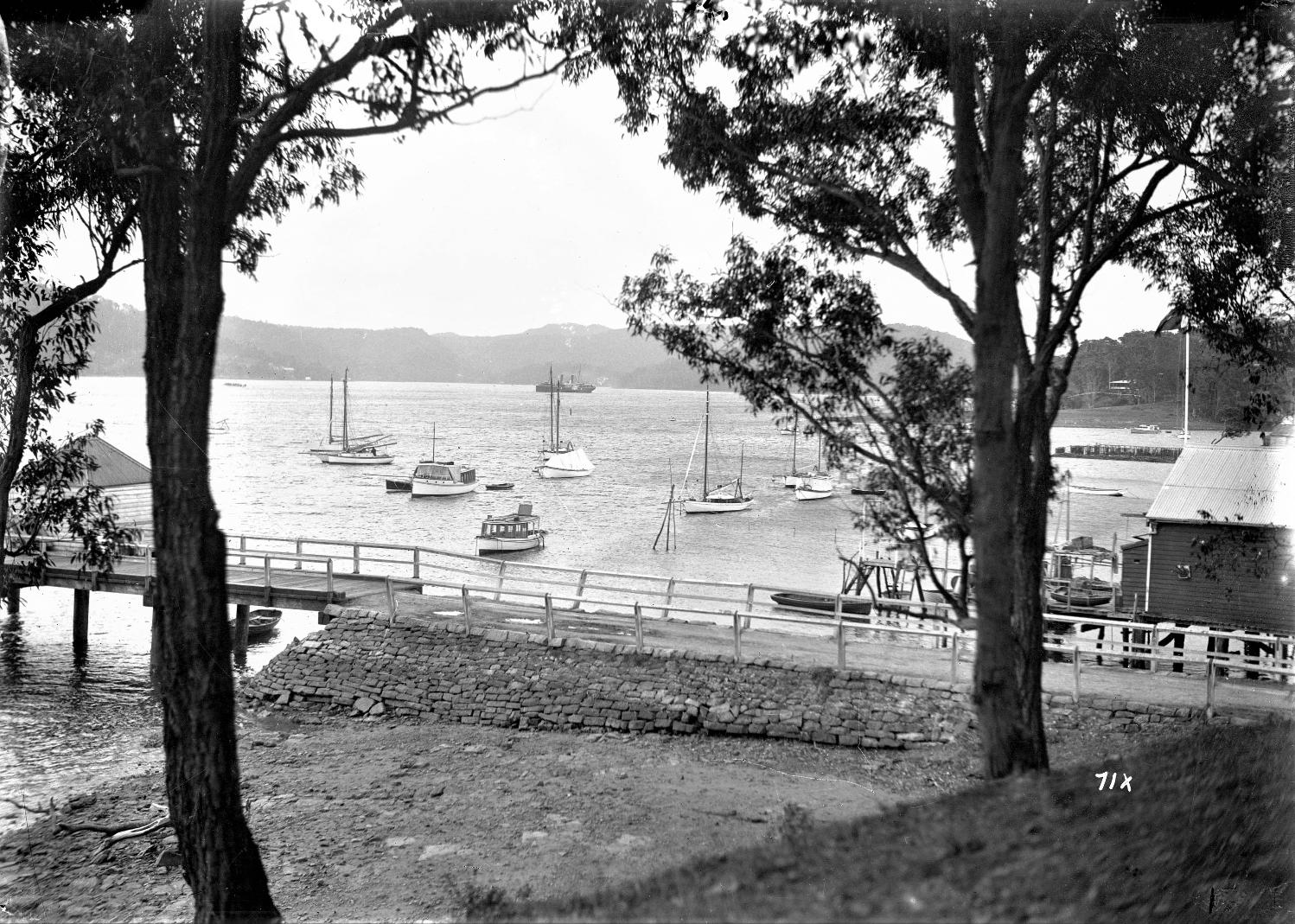Newport Hotel wharf named for queen Victoria
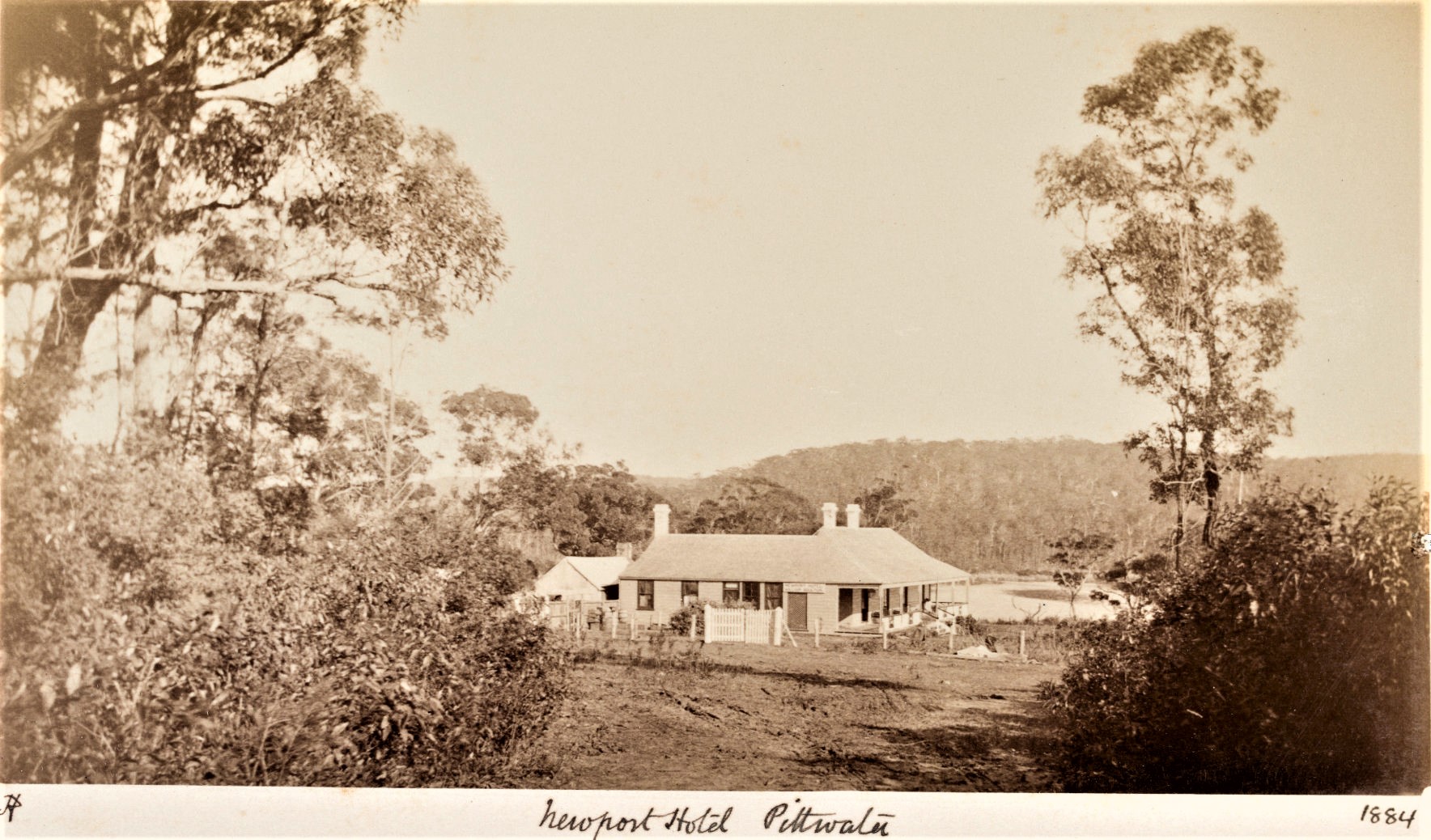
Newport Hotel, circa 1884, a Robert Hunt photograph, courtesy State Library of NSW
The second Royal visitors to our shores, Princes Albert and George, grandfather of Her Majesty Queen Elizabeth II, came here in 1881 for a visit, boarding a steamer at Newport Wharf for a tour along the Hawkesbury River. They travelled overland in a coach they boarded at Manly – their relative’s experience at Clontarf not deterring a chance to see the beauty of this place. Newport Wharf, the first version - which was then called 'Victoria Wharf' after these young princes grandmother - Queen Victoria, had just been completed, partly in anticipation of having these princes as guests and being able to take them on a scenic cruise around Pittwater and up the famed Hawkesbury aboard a steamer called the 'Pelican' - owned by the gentleman who had also built the wharf and the first version of the Newport Hotel.
The newspapers of then tells us they visited our area on Monday August 1st, 1881 - so around this time of year, but 141 years ago. That bit from that report reads:
Yesterday morning a party from Government House and the Detached Squadron made an excursion up the Hawkesbury, and fortunately the weather was so fine that every lovely scene on the river appeared to the best advantage.
The Royal Princes were of the party. At an early hour those engaging in the excursion left Man-o'-war Stairs, and proceeded in the steam launch Nea to Manly, whence they were conveyed by Mr. Boulton's coaches to Newport. There they were received by Mr. Jeannerett on board the steam launch Pelican. Barrenjoey was passed about 11 o'clock. At Barrenjoey Mr. A. T. Black and friends were invited on board the Pelican and the boat then proceeded up the river.
The day being beautifully clear, the scenery of the Hawkesbury was, seen to the best advantage, and was very much admired. Wiseman's Ferry was reached about 3 o'clock in the afternoon. The Pelican stopped at the wharf for a few minutes, and on the Princes appearing the residents assembled, and an address of royal welcome was read and presented to them by the master of the Public school, on behalf of the inhabitants of the village. The school children sang the " National Anthem," and those assembled then gave three hearty cheers for the Queen and the Princes. Prince Edward acknowledged the, compliment in a few appropriate words. The arrangements made by Mr. Jeannerett for the comfort and convenience of the party appeared to give great satisfaction. The Pelican resumed her journey, and we. up the river as far as Sackville Roach, at which spot the party disembarked, and drove thence to Windsor, returning from Windsor to Sydney by special train at night.
The Princes slept at Government House, and will probably remain guests of Lord Augustus Loftus for a few days, after which they will rejoin their old ship the Bacchante, which has now finished her coaling and provisioning.. THE DETACHED SQUADRON. (1881, August 2). The Sydney Morning Herald (NSW : 1842 - 1954), p. 5. Retrieved from http://nla.gov.au/nla.news-article13491533
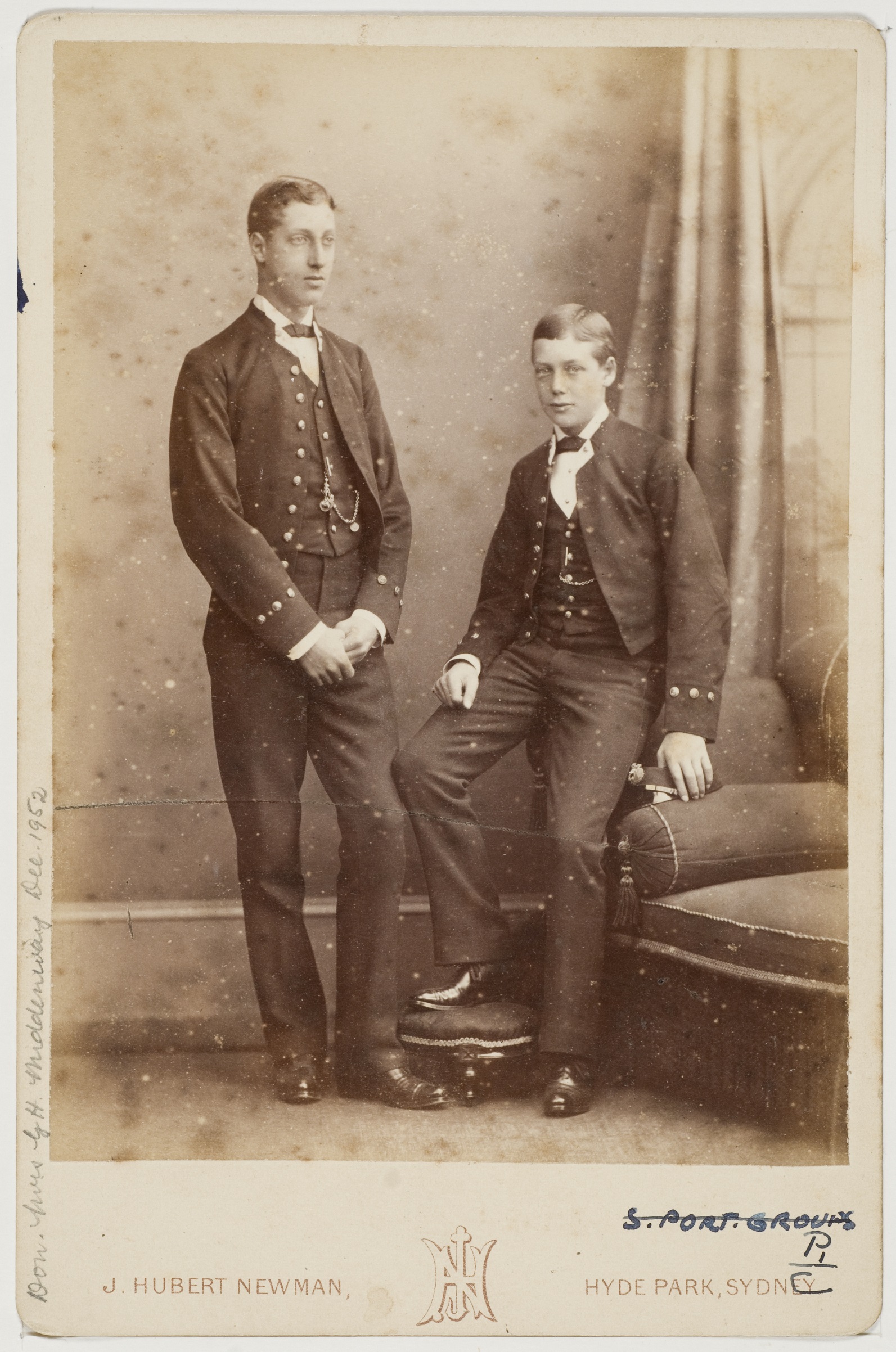
HRH Prince Albert Victor Christian Edward, Duke of Clarence, and HRH Prince George Frederick Ernest Albert of Wales as midshipmen in the Royal Navy, 1881 / photographer J. Hubert Newman, Sydney - photo courtesy of the State Library of NSW
What today we know as the Newport Wharf at the end of Queen’s parade (west) below current Newport Arms hotel began as a pier circa 1879-1881 which was built by Charles Edward Jeannerett in anticipation of developing then heavily wooded and pristine Newport. Although seemingly nameless for this period, it would have been described in terms by those who were eye witnesses early and by advertising material for contractors by real estate developer George Pile, real estate speculator, agent and auctioneer, who was contracted to aid in this venture:
January 1880: TO CONTRACTORS – TENDERS are wanted for clearing roads and about forty acres of land at the new Pittwater Marine Township. Apply Mills and Pile, 112, Pitt Street. Advertising. (1880, January 19). The Sydney Morning Herald(NSW : 1842 - 1954), p. 2. Retrieved from http://nla.gov.au/nla.news-article13450418
But our steamer, the good ship Florrie, owned by Mr. Jeannerett, is in waiting, lying alongside a jetty at the head of the bay, so we immediately embarked for our destination, Barrenjoey, a distance of about eight miles. On the opposite side of the bay is New Port, the property of Messrs. Mills and Pile and Mr. Jeannerett, who are erecting an hotel, for the accommodation of visitors to the bay. It will have a fine situation; and when the place becomes more widely known, as it deserves to be, the hotel will doubtless be largely availed of. LAYING the FOUNDATION-STONE of a NEW LIGHTHOUSE at BARRENJOEY. (1880, April 17). The Sydney Morning Herald (NSW : 1842 - 1954), p. 7. Retrieved from http://nla.gov.au/nla.news-article13458288
Although Piles and Jeannerett did not officially own land here until February 1880, as some sources state, they clearly had rights enough from late 1879, and their words as gentlemen who were already contributing much to the development of Sydney both as standing to represent Canterbury and local MP’s or Councillors (Pile was defeated at elections he stood for in November, 1880, only getting 493 votes; two representatives, William Piggott and William Henson were voted in, getting 2,513 (42.11%) and 1,380 (23.12%) respectively). Jeannerett was an alderman of Hunter's Hill and mayor in 1870-71, 1877-78 and 1890. From 1886 he represented Bourke ward in the Sydney City Council. As a magistrate he administered 'strict justice and sound common sense' in the Water Police Court. He was defeated for Central Cumberland in 1875, he represented Carcoar in the Legislative Assembly in 1887-89 and 1891-94 as a free trader. (1.)
Department of Public Works: (Contracts and Tenders;) Sydney May 21st 1880: Road, Manly to Pittwater-Contracts 1 and 1L . Advertising. (1880, May 22). The Sydney Morning Herald (NSW : 1842 - 1954), p. 10. Retrieved from http://nla.gov.au/nla.news-article13460485
They purchased land from the then released Basset-Darley Estate:
At Pittwater the Bassett Darley estate was sold in two parts. In 1880 Charles Edward Jeanneret and George Pile paid 732 [pounds sterling] for 118 acres on which to establish the New Marine Township of Newport, (49) while the remaining land, apart from a one acre lot purchased by the Church of England, was bought by John William Cliff for 8000 [pounds sterling] in 1886. (50)
(49) Land Titles Office, Old System Deeds Book 201, No. 916; Book 224, No. 576.
(50) Land Titles Office, Old System Deeds Book 340, No. 647.
Soon what was called Newport Hotel a few years before it had a licence, featured in advertisements for forthcoming sales for the by then named ‘Marine Township of Newport’. A similar notice appeared in all major capital city newspapers:
We have received from Messrs. Mills, Pile, and Gilchrist, (who have published it for the proprietors) an interesting pamphlet descriptive and illustrative of the beauties and attractions of Newport, Pittwater, and the celebrated Hawkesbury lakes. The work consists of about eight pages of letter-press and nine carefully lithographed drawings, depicting the more important scenes and places of interest in the locality. The description is capably written, and the illustrations, lithographed by Messrs. S. T. Leigh and Co., from water colour drawing- by Mr. H. Brees, are very creditably executed, and give excellent ideas of the places represented. Appended is a plan and local sketch of the new marine township of Newport, and altogether the publication is one which will commend itself highly to all interested in one of the most picturesque spots on the New South Welsh coast. NEW'S OF THE DAY. (1880, August 26). The Sydney Morning Herald (NSW : 1842 - 1954), p. 5. Retrieved from http://nla.gov.au/nla.news-article13466890
You can see the list of H Brees drawings of Newport used in these lithographs at the National Library of Australia HERE
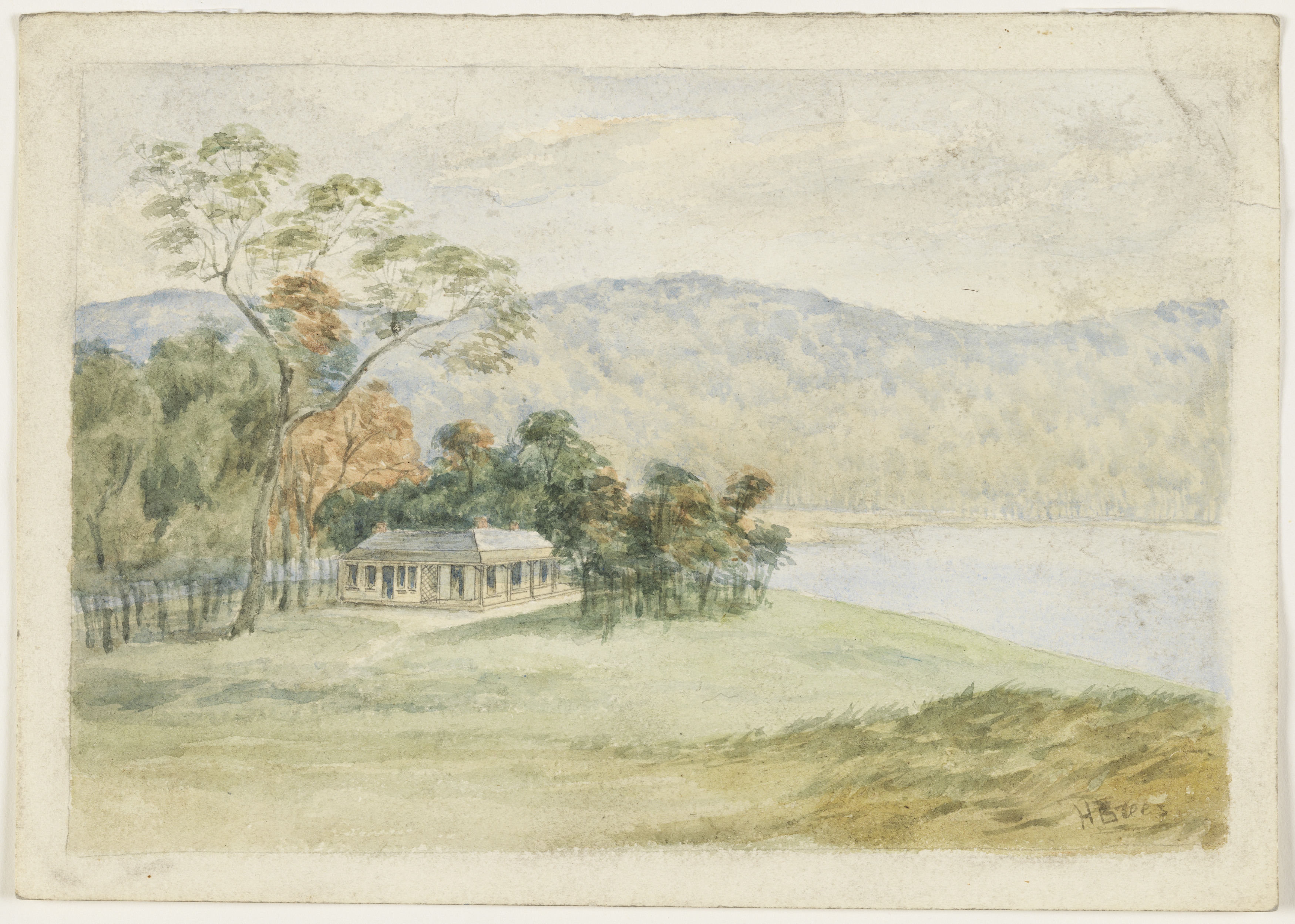
Newport Hotel, from album Pittwater scenes, 1880 / Harold Brees courtesy State Library of NSW - note the Telegraph wires. The drawings appear to be the originals for six of the lithographs illustrating 'The Pittwater and Hawkesbury Lakes album'. [Sydney] : Mills, Pile & Gilchrist, 1880. (Lithographed by S.T. Leigh & Co.)courtesy State Library of NSW
Lane Cove and Pittwater.
(BY OUR TRAVELLING REPORTER.):
Another trip I took very recently, via Manly to Pittwater, or rather Newport, as I suppose it will in future be known by. I was fortunate enough to be included in a party of four, and, like the previous one, found this journey an extremely pleasant one. Taking a couple of conveyances from Manly, we drove on a very well made road 'some 14 miles or so, passing enroute through a very large shallow lagoon, connected with the ocean by a narrow outlet. I was informed that it was the duty of some official to so " manipulate" the sandbank at the latter place as to keep the crossing place as safe as possible, by allowing free outlet for the water. It is to be hoped that this gentle-'man does not neglect his work, as I understand it is a matter that requires constant attention. Arrived at the embryo township of Newport, we had just time to give a passing glance around before our brief sojourn was over. There is already a small quay where the American pine is landed that the one house-an hotel-is being partly constructed of. The place is very beautiful, and the gentlemen interested therein, Messrs. Mills, Pile, and Jeannerett, deserve well of the Sydney people for their enterprise in making another "extra desirable" resort of the metropolitan citizens. I may mention, concerning the lagoon we had to got through, that a bridge thereon is already on the tapis, that will place Newport within three hours of the General Post-office. And thus, so far; ends, my suburban pilgrimage, which I have as heartily enjoyed as anything of the sort it has been my good fortune to experience. Lane Cove and Pittwater. (1880, August 28). Australian Town and Country Journal (NSW : 1870 - 1907), p. 18. Retrieved from http://nla.gov.au/nla.news-article70947110
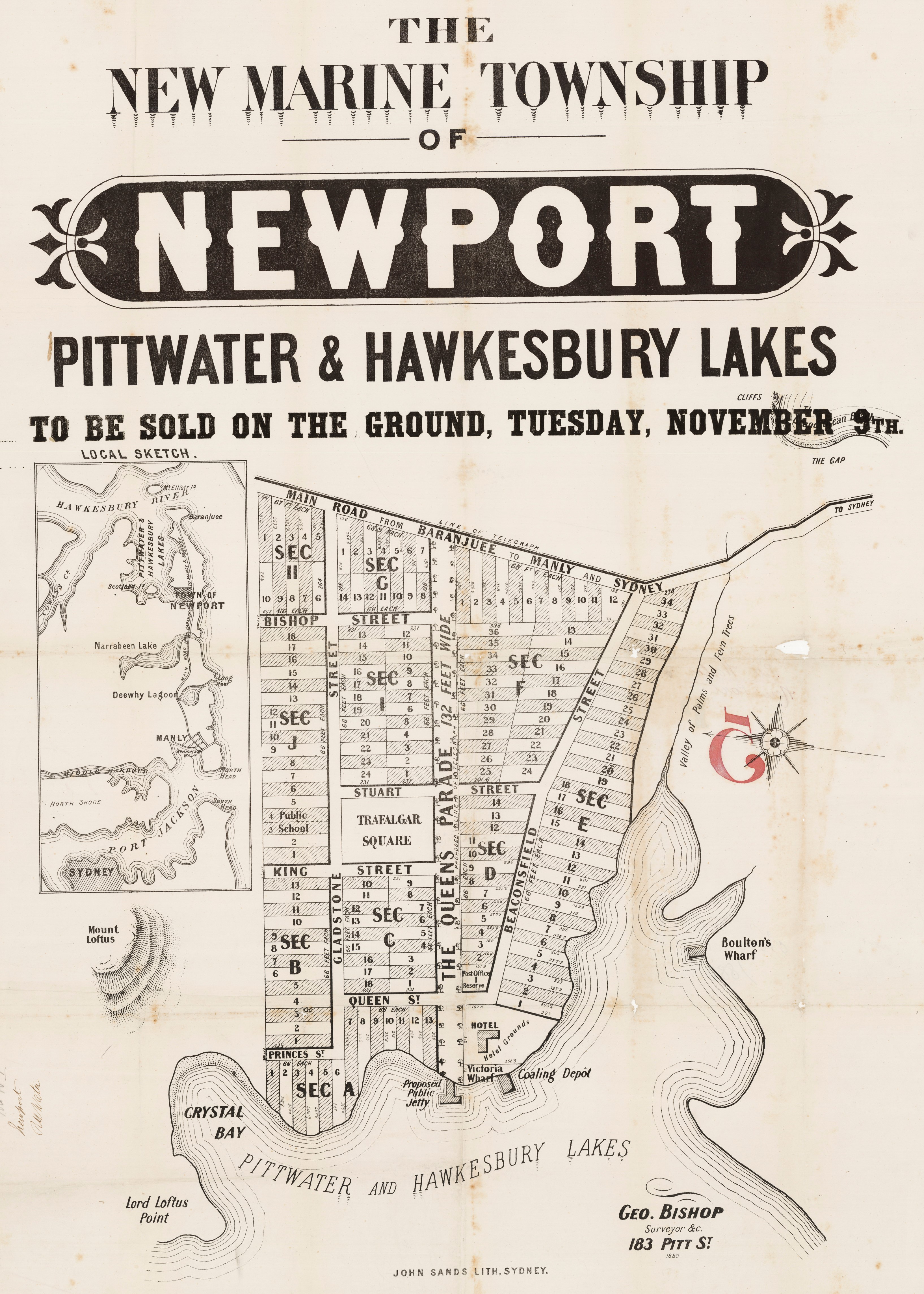
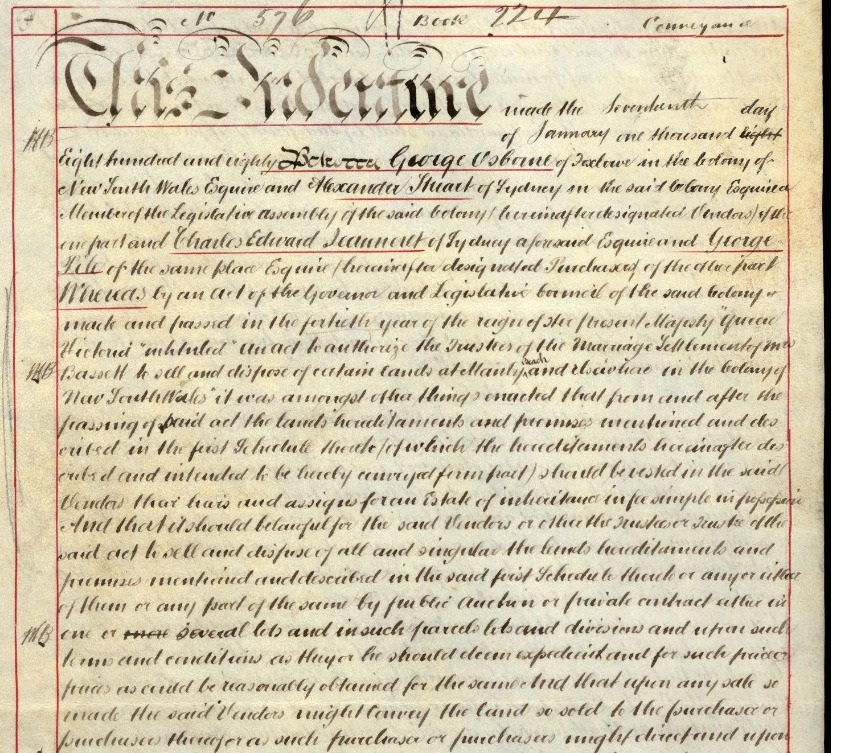
%20Newport%20land%20jeanerrett%20Giles.jpg?timestamp=1629760598410)
%20Newport%20land%20jeanerrett%20Giles.jpg?timestamp=1629760623019)
Images courtesy HRLV - Book 224 Volume 576
Charles Jeannerett, one of the partners in the Parramatta and River Steamers, who had taken over the Florrie’s Government mail contract from Blackwell John Davis, shipbuilder who had originally been contracted to build this vessel and run the mails, began allowing other steamer companies to land tourists as soon as he could;
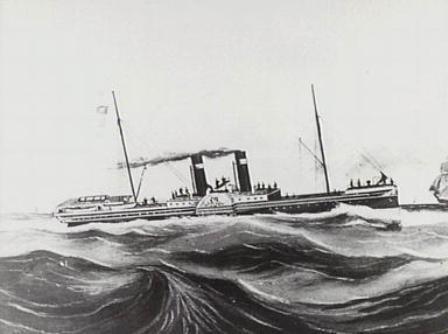 QUEEN'S BIRTH DAY. SELECT and FAMILY EXCURSION to PITTWATER and HAWKESBURY LAKES, and the New Marine Town of NEWPORT. The fast, powerful, and steady Steamship KEMBLA, has been engaged, and will leave the CIRCULAR QUAY, at 9am, returning at 7 p m. At this season of the year the sea is as smooth as a pond, and a delightful trip may confidently be anticipated. Every arrangement will be made to ensure the comfort of each PRIVATE PICNIC PARTY, and the MAGNIFICENT SCENERY of PITTWATER, and the Lower Hawkesbury, will be seen to the best advantage. TICKETS, 5s EACH May be obtained on board, or at the KING-STREET WHARF; MR MADDOCK, George-street. Advertising. (1880, May 18). The Sydney Morning Herald (NSW : 1842 - 1954), p. 2. Retrieved from http://nla.gov.au/nla.news-article13460203
QUEEN'S BIRTH DAY. SELECT and FAMILY EXCURSION to PITTWATER and HAWKESBURY LAKES, and the New Marine Town of NEWPORT. The fast, powerful, and steady Steamship KEMBLA, has been engaged, and will leave the CIRCULAR QUAY, at 9am, returning at 7 p m. At this season of the year the sea is as smooth as a pond, and a delightful trip may confidently be anticipated. Every arrangement will be made to ensure the comfort of each PRIVATE PICNIC PARTY, and the MAGNIFICENT SCENERY of PITTWATER, and the Lower Hawkesbury, will be seen to the best advantage. TICKETS, 5s EACH May be obtained on board, or at the KING-STREET WHARF; MR MADDOCK, George-street. Advertising. (1880, May 18). The Sydney Morning Herald (NSW : 1842 - 1954), p. 2. Retrieved from http://nla.gov.au/nla.news-article13460203
Left: The Kembla was originally a 325 gross tons, 204 net. Lbd: 185'1" x 22'1" x 11'5". Iron paddle steamship built by J Reid & Co., Glasgow for the Illawarra S N Co., Sydney. Of 2 cylinder LP producing 165 horsepower and capable of 14 knots. Lengthened in 1873 becoming of 449 gross tons, 283 net with Lbd: 209'2" x 22'6" x 11'5". Owned by C J Stevens who formed the Newcastle Steamship Co Ltd. (6.)
One of the most’ successful excursions that has taken place during the season was that which was held yesterday to Pittwater and the Hawkesbury River. The glorious scenery of this matchless river doubtless had the effect of inducing so large a number of persons to assemble on board the good ship Kembla, which was lying at the Circular Quay yesterday morning, ready to convey intending excursionists. At a quarter to 10 precisely the Kembla cast off her moorings and steamed away, having on board at least 800 people. The weather was magnificent, and the trip a most enjoyable one to most of those on board, though some were to be met with suffering from mal de mer. Barrenjuey was rounded about 12, and the glorious scenery which burst upon the view of the excursionists, and which was seen for the first time by most of them, excited universal admiration. At a quarter to one the Kembla was brought up alongside the wharf at Newport, and the majority of her living freight, after getting ashore, dispersed in various directions. Refreshments were to be had in plenty on board the steamer, and about 150 partook of luncheon in the saloon. At four o'clock, when every spot worth visiting had been thoroughly "done" by most of the excursionists, the party re-embarked. The steamer was then headed down the bay, and after a pleasant run of about three-quarters of an hour Mount Elliott was rounded, Captain Skinner having kindly decided to give his passengers an additional treat by a trip into the entrance to the Hawkesbury. This was looked upon as a great treat, and frequent exclamations of delight were heard as each point of interest and beauty was passed. After going up the estuary about five miles, Captain Skinner turned his vessel's head homewards, and after a pleasant passage the Kembla was brought up alongside her wharf in Darling Harbour. No accident of any kind occurred to mar the day's enjoyment, and the almost universal verdict was that tie excursion was about the most successful, in every respect, that has been, held this season. HARBOUR EXCURSIONS. (1880, May 25). The Sydney Morning Herald (NSW : 1842 - 1954), p. 3. Retrieved from http://nla.gov.au/nla.news-article13460708
PRINCE OF WALËS' BIRTHDAY.-EXCURSION to NEWPORT, BROKEN BAY. The fast and favourite steamship ILLAWARRA will leave the I. S. N. Company's Wharf next TUESDAY, 9th November, at 1130 a.m. Tickets, 5s ;children, half-price. At MADDOCK'S, or on the Wharf; Brass band engaged. Advertising. (1880, November 5). The Sydney Morning Herald(NSW : 1842 - 1954), p. 2. Retrieved from http://nla.gov.au/nla.news-article13478150
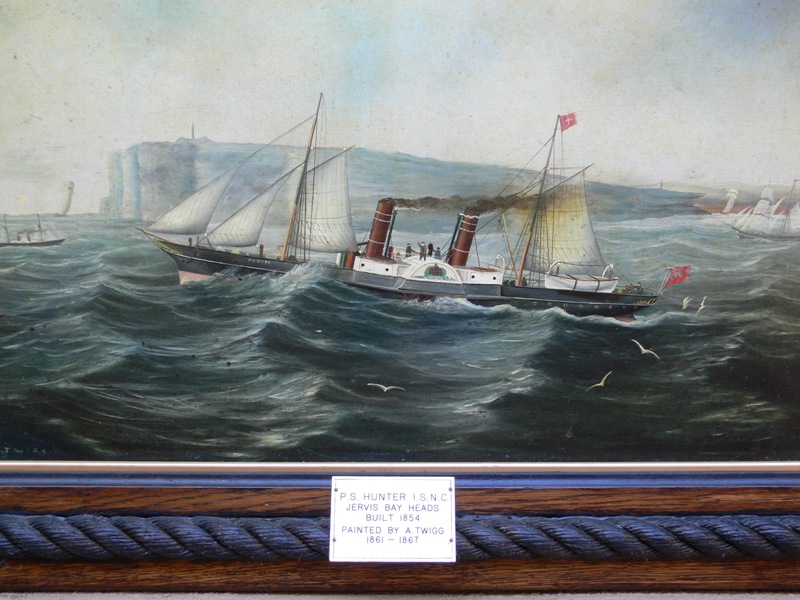
EXCURSION to NEWPORT, PITTWATER, and BROKEN BAY. The favourite steamship HUNTER will leave the Illawarra Company's Wharf, Erskine-street, at 10a.m. on SATURDAY next, for NEWPORT WHARF, BROKENBAY. Brass Band engaged. RETURN FARE, 5s; CHILDREN HALF-PRICE. Luncheon obtainable on board. NEW YEAR'S DAY. NEWPORT. PITTWATER. THE BEST PICNIC LAND KNOWN. THE TERMINUS OF THE HAWKESBURY. THE HEAD OF PITTWATER NAVIGATION. ONLY 10 MILES FROM MANLY. GO BY STEAMER and COME BACK BY ROAD, or to MANLY and BACK BY ROAD. COACHES by FARRELL, BOLTON, and FRASA. MAKE YOUR OWN ARRANGEMENTS IN TIME. SAME FARE AS STEAMERS. NEWPORT, NEWPORT, PITTWATER. NEW YEAR'S DAY. The ILLAWARRA CO.'S STEAMSHIP HUNTER will leave the COMPANY'S WHARF, on NEW YEAR'S DAY, 9.30 a.m , DIRECT FOR NEWPORT, RETURNING in the Evening. See Newspaper Reports on the KAMARUKA Boxing Day Trip. Advertising. (1880, December 30: Thursday). The Sydney Morning Herald(NSW : 1842 - 1954), p. 2. Retrieved from http://nla.gov.au/nla.news-article13480589
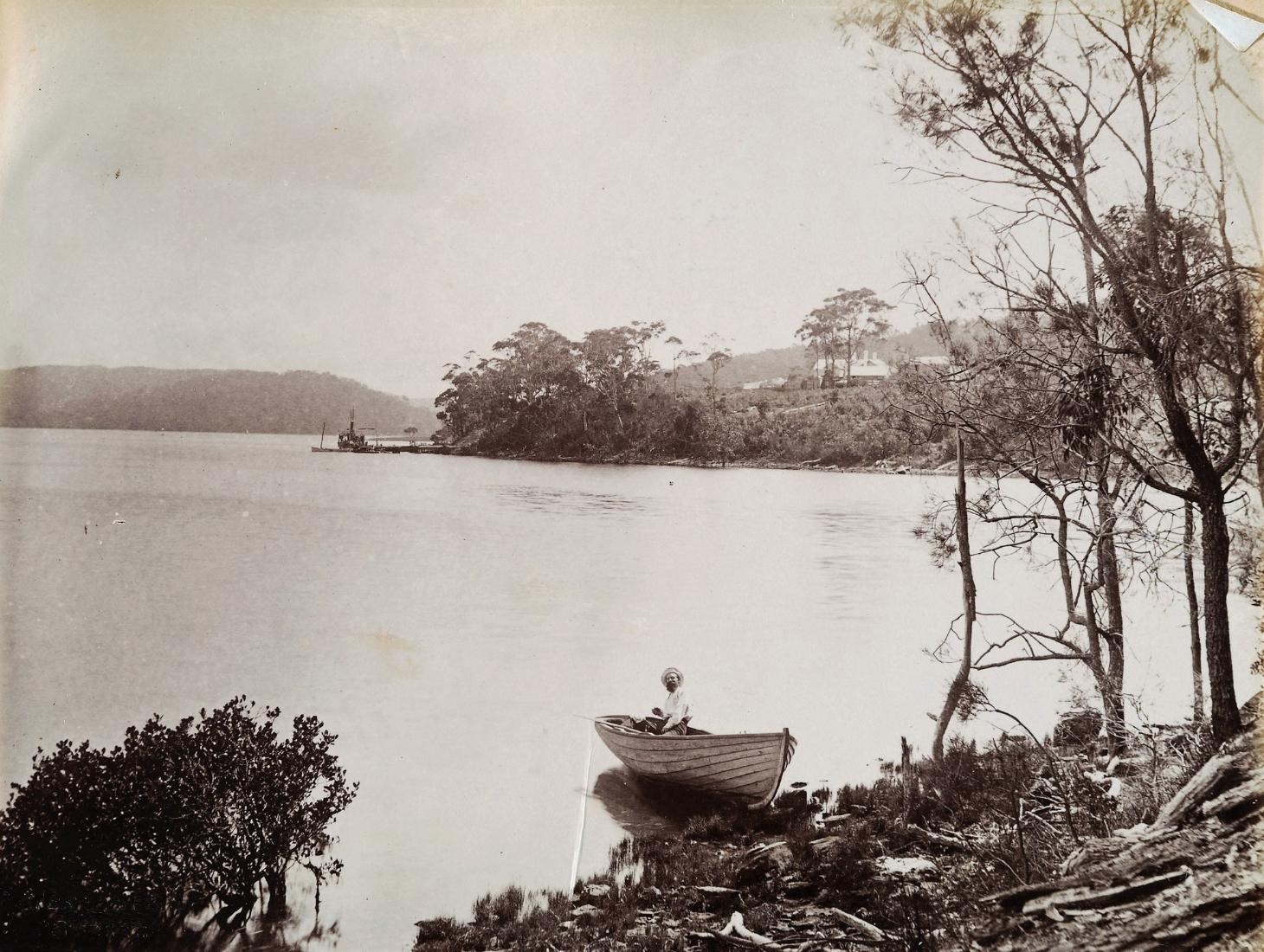
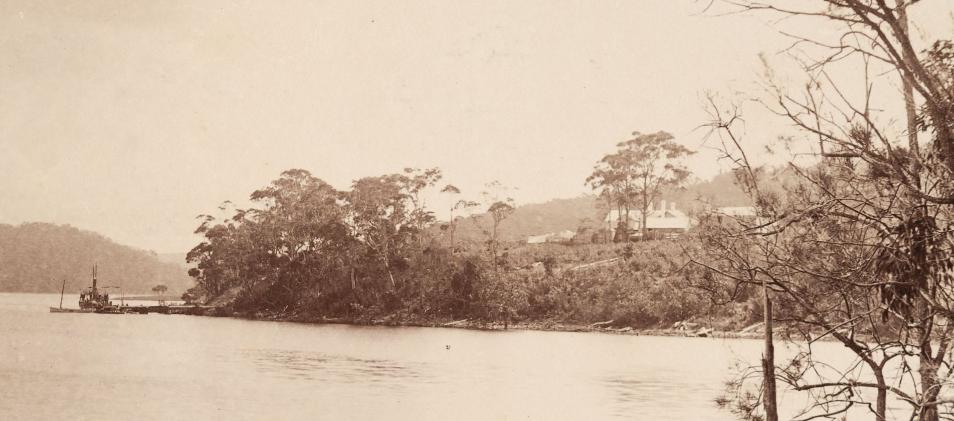
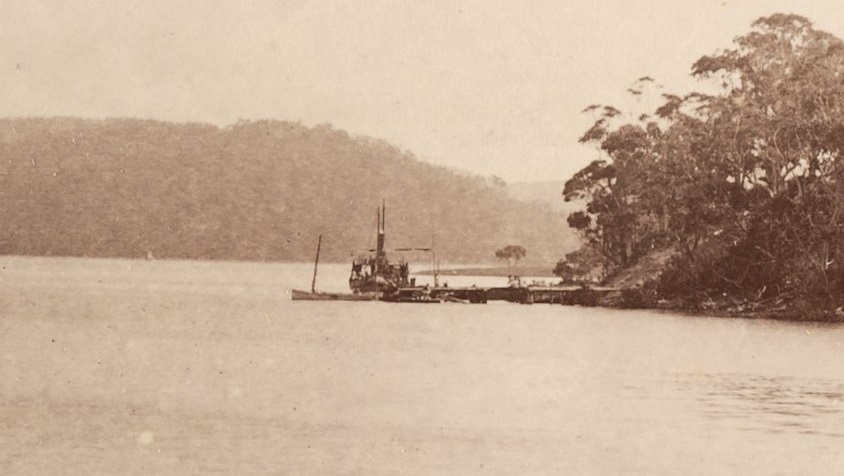
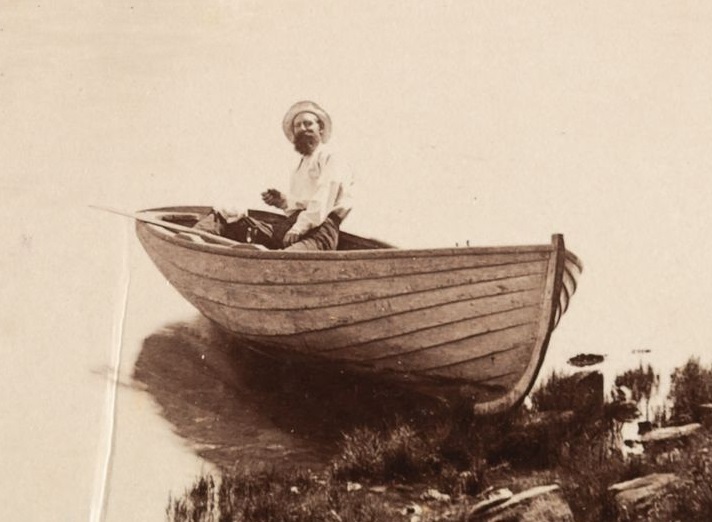
Other reports of this trip from Manly state the Princes being amazed at the sight of the steamer Collaroy, beached at Long Reef, which later gave it's name to this area and stretch of sand. This steamer regularly made her way to Pittwater. On the way to escorting the Princes to the Hawkesbury Mr Jeannerett made sure to stop and gather his host from the lighthouse ground breaking ceremony:
At Barrenjoey Mr. A. T. Black and friends were invited on board the Pelican and the boat then proceeded up the river. THE DETACHED SQUADRON. (1881, August 2). The Sydney Morning Herald (NSW : 1842 - 1954), p. 5. Retrieved from http://nla.gov.au/nla.news-article13491533
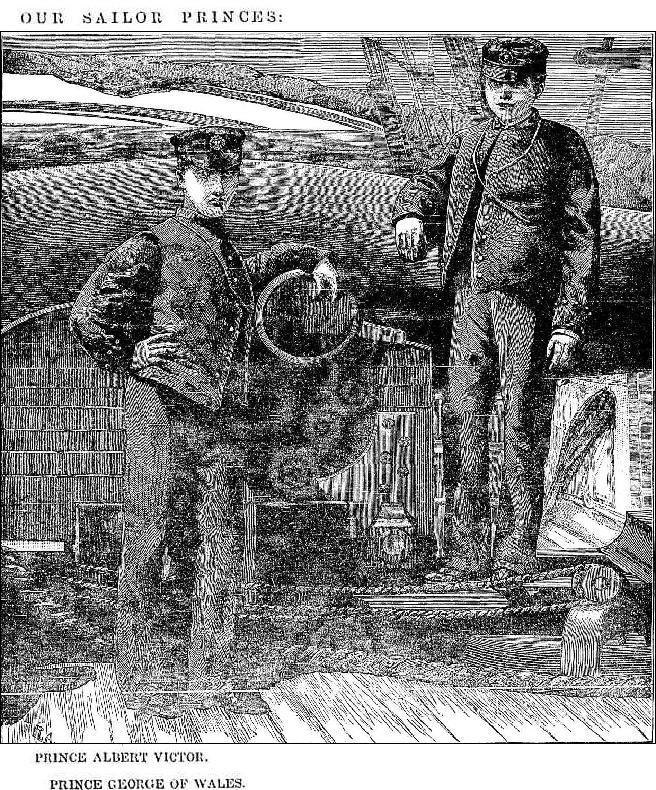
OUR SAILOR PRINCES: PRINCE ALBERT VICTOR. PRINCE GEORGE OF WALES. PRINCE ALBERT VICTOR. PRINCE GEORGE OF WALES. OUR SAILOR PRINCES. (1881, May 7). The Australasian Sketcher with Pen and Pencil (Melbourne, Vic. : 1873 - 1889), p. 145. Retrieved from http://nla.gov.au/nla.news-article60622448
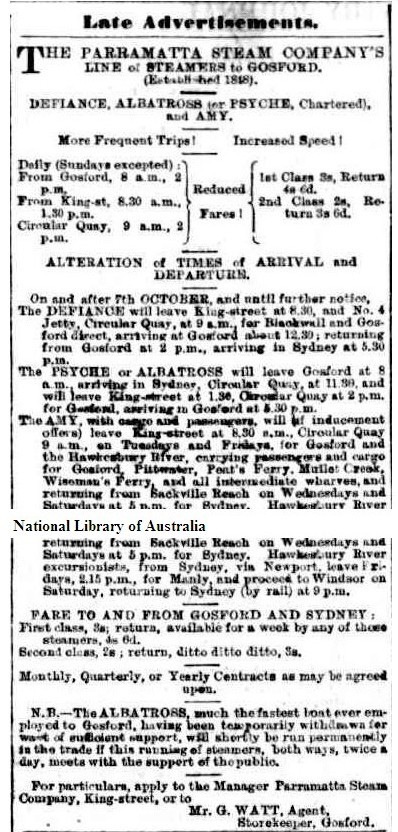 THE HAWKESBURY RIVER AND PITT WATER STEAM NAVIGATION COMPANY, LIMITED.
THE HAWKESBURY RIVER AND PITT WATER STEAM NAVIGATION COMPANY, LIMITED.
To be Registered, and the Liability of the Shareholders Limited under the Companies' Act. The above Company is proposed to be formed for the purpose of establishing a regular and efficient Steamship Service between Sydney, Pittwater, and various places upon the Hawkesbury River. It is proposed that the Company purchase the steamers and wharfage rights of Mr. C. E. Jeanneret and Messrs. Melvey and Ford, who are now conducting the passenger and goods traffic between Sydney, Pittwater, and the Hawkesbury River. The purchase will also include the goodwill of the business carried on by Mr. Jeanneret and that of Messrs. Melvey and Ford. The steamer Amy will be sold to the Company by Mr. Jeanneret and the Moramara by Messrs. Melvey and Ford.
The wharfage rights of the vendors consist of- '
1. The occupation by lease of a wharf at Peat's Ferry at, present held by Mr. Jeanneret.
2. The lease of a wharf in course of construction at Peat's Ferry held by Messrs. Melvey and Ford.
3. A "Wharf at Flat Rock Point upon the Hawkesbury River, held by Mr. Jeanneret, from the Crown.
4. Freehold land at Newport with Wharf, known as Victoria wharf.
5. The wharfage right of Mr. C. E, Jeanneret for the unexpired residue of the term of two years over portion of No. 4 Jetty, Circular Quay, Sydney, for the purpose of embarking passengers and their goods.
In addition to the above properties a Cottage and Water Tank at the Basin, Pittwater, as now held under licence from the Crown will be transferred to the Company.
The Vendors can also arrange with the Company for storage and wharfage of goods if required, at a fixed rate.
The capital of the Company will be £10,000 divided into 10,000 shares of £1 each. Of these 4000 will be allotted as fully paid up to the vendors, Messrs. C. E. Jeanneret and Messrs. Melvey and Ford, and the balance of 6000 shares will be offered to the public upon the following terms of… Advertising. (1885, August 29). Australian Town and Country Journal (NSW : 1870 - 1907), p. 8. Retrieved from http://nla.gov.au/nla.news-article70983085
At Right: Gosford move by Parramatta Steamer Co: Advertising. (1885, October 3). Australian Town and Country Journal (NSW : 1870 - 1907), p. 42. Retrieved from http://nla.gov.au/nla.news-article70984606
Soon after the lead up 'blurbs' the first official notices for sale of Newport lots appeared:
PRINCE OF WALES BIRTHDAY. SALE OF ALLOTMENTS IN THAT CHARMING SANATORIUM, NEWPORT, THE LOVELIEST SPOT IN AUSTRALIA.DON'T FORGET TO ATTEND THE SALE, THE TOWNSHIP IS LAID OUT ON A GRAND SCALE. THE MAIN-STREET IS 2 CHAINS WIDE. Call for a Lithograph, MILLS, PILE, and GILCHRIST, Auctioneers. PRINCE OF WALES BIRTHDAY. THE GREAT SALE of the SEASON. THE MOST GLORIOUS PICNIC. THE GREAT SALE of the NEW WATERING PLACE, NEWPORT. AT THE HEAD OF PITTWATER, CLOSE TO MANLY. THE PORT OF THE HAWKESBURY. REGULAR COACH ACCOMMODATION TO MANLY-. REGULAR COMMUNICATION BETWEEN BRISBANE WATER.THE STARTING PORT of the HAWKESBURY STEAMERS. THE MOST BEAUTIFUL RETREAT in NEW SOUTH WALES. ATTEND THE SALE' on the 9th NOVEMBER. PRINCE OF WALES' BIRTHDAY". THE FIRST SALE OF ALLOTMENTS IN THE NEW MARINE TOWNSHIP OF NEWPORT. MILLS, PILES and GILCHRIST will sell by public Auction, on the GROUND, NOVEMBER 9th, at 2 p.m . SEVERAL SECTION'S IN THAT MOST PROMISING TOWNSHIP, which possesses the following advantages :
IT IS NEAR a beautiful OCEAN BEACH, at the head of a lovely- bay, between romantic headlands. It has extensive frontage to the deep waters of PITTWATER LAKE. THE LINE of STEAMERS for-BRISBANE WATER and the Hawkesbury start from the NEWPORT WHARF. THE SCENERY is beautiful in the extreme, the views from the adjacent mountains are most extensive, the vegetation superb. IT WILL he the head centre of YACHTING and FISHING PARTIES. AS A PROOF of its prospects, it may be mentioned that although the HOTEL (now an accommodation house only, until a license is got for it) has only been occupied ONE MONTH, yet the tenant has made APPLICATION for 12 additional rooms, and offered to contribute to the cost of the same. THE PROPRIETORS have so high an opinion of the FUTURE of NEWPORT, that they have decided to sell only a portion thereof, and hold the remainder for some years to come. ATTEND THE SALE. LIBERAL TERMS. LITHOGRAPHS NOW READY. Advertising. (1880, November 5). The Sydney Morning Herald(NSW : 1842 - 1954), p. 10. Retrieved from http://nla.gov.au/nla.news-article13478153
FOR SALE AT THE ROOM'S, 114, PITT-STREET, some FINE BUSINESS SITES in the TOWNSHIP OF NEWPORT, suitable for Hotels and Shops. A good business will be done there before long, Newport being the true PORT OF THE HAWKESBURY. The terms will be £5 deposit on each lot, and the balance 20s per month. Advertising. (1880, November 24). The Sydney Morning Herald(NSW : 1842 - 1954), p. 13. Retrieved from http://nla.gov.au/nla.news-article13483571
This newer version was obviously built to accommodate a rise in steamers bring 'excursionists' to Pittwater, many of whom were offloaded at Newport Wharf for the hotel luncheon - the following gives a description of its specifications. William Boulton was now the gentleman who would transfer the licence of the Newport Hotel to succeeding licencees - in 1886 he purchased the hotel and held onto this until it was sold by his relatives, years after he passed away, in 1919:
Department of Lands,
Sydney. 19th September, 1884.
APPLICATIONS TO ERECT JETTIES ON PILES.
NOTICE is hereby given that applications have been made by the parties hereunder mentioned for permission to erect jetties in front of their property, particularized in the annexed description; and all persons interested are invited to state within one month from this date, their objections, if any, to the proposed erection of the jetties.
JAMES S. FARNELL.
William Boulton.
County of Cumberland, at Pittwater, Newport, parish of Narrabeen : Commencing on the high-water mark of Pitt water, at a point bearing south 55 degrees east (magnetic), and distant 40 feet from the south-west corner of applicant's property j and bounded thence on the north-west by a line bearing south 30 degrees west 66 feet; thence on the south-west by a line at right angles bearing southeasterly 25 feet; thence on the south-east by a line parallel to the first mentioned boundary bearing north-easterly to the aforesaid high-water mark ; and thence on the north-east by that high-water mark north-westerly, to the point of commencement.
APPLICATIONS TO ERECT JETTIES ON PILES. (1884, September 26). New South Wales Government Gazette (Sydney, NSW : 1832 - 1900), , p. 6439. Retrieved from http://nla.gov.au/nla.news-article221676545
Newport was named the Land of Lemons and Oranges at this time due to a prevalence of farms and farmers (Heron Cove: Pittwater Waters History Month, Nov. 2011). With the numerous vessels now pulling into the wharf and offloading seemingly thousands of people each week, improvements and making this an official public wharf, not just named as the 'Newport Hotel Wharf' was asked for:
MESSRS, BURNS AND CULLEN, members for St Leonards, brought under the notice of the Minister for Works yesterday the movement at Pittwater for the erection of a public wharf at Newport. They presented an influentially-signed petition in favour of the erection of a wharf at Sunnyside, and stated that another petition, praying that the wharf be erected at the foot of Queen's-parade, in the same quarter, had been sent to the Minister for Lands. Mr. Bruce Smith promised to make the necessary inquiries as to the necessity for the wharf, and to let the deputation know the result. The Sydney Morning Herald. (1889, May 22). The Sydney Morning Herald (NSW : 1842 - 1954), p. 8. Retrieved from http://nla.gov.au/nla.news-article13725373
Perhaps this 'public' wharf was called for due to this Notice:
To avoid misunderstanding and inconvenience, it is hereby notified that, by agreement with the lessee of the Newport Hotel, and Jetty connected therewith, for a term of years, the Hunter River New Steam Navigation Company has the SOLE and EXCLUSIVE RIGHT (excepting only the regular small vessels) of calling at the said Newport jetty to land and embark passengers on such days as the said Company choose to run excursion trips with their steamships.
THOS. H. HODGES, - Lessee of Newport Hotel and Jetty.
F. J. THOMAS, Manager H.R.N.S.N. Co. 15th December, 1890.
POPULAR EXCURSIONS per H.R.N.S.N. CO.'S . STEAMERS.
PROPOSED EXCURSIONS DURING HOLIDAYS.
Newcastle to Port Stephens, Boxing Day, 26th Dec.
Sydney to Newport, Boxing Day. 26th Dec.
to Hawkesbury Bridge, &c., .Saturday Afternoon, 27th Dec.
to Newport. New Year's Day, 1st Jan.
to Hawkesbury Bridge, &c., New Year's Day, 1st Jan.
to Newport, Sunday, 11th Jan.
„ * „ Anniversary Day, 26th Jan. Advertising (1890, December 20). Evening News (Sydney, NSW : 1869 - 1931), , p. 1. Retrieved from http://nla.gov.au/nla.news-article113746346
The steamers, loaded with visitors, kept coming, sometimes all at once:
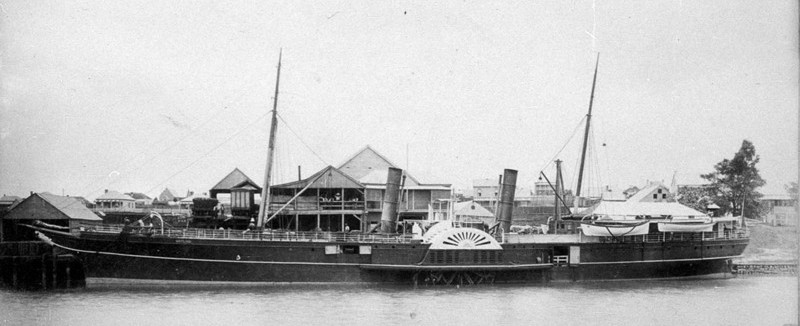
SS Maitland, 1884, at Maitland wharf! Image no: BCP 05329, courtesy State Library of NSW.
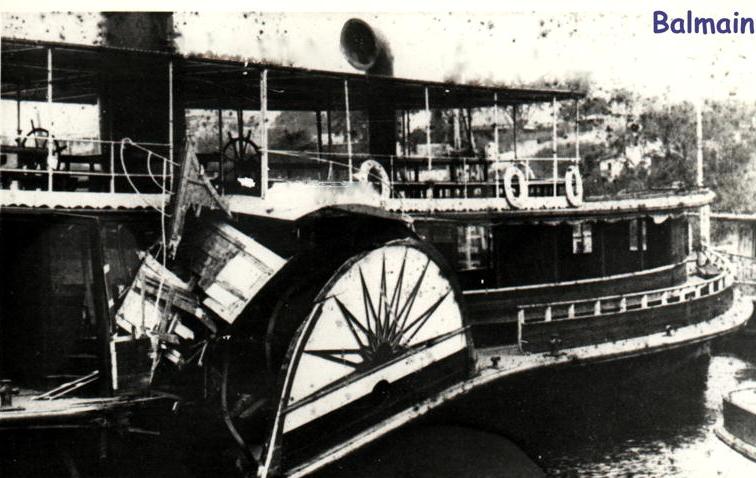 The Maitland left the wharf in Darling Harbour crowded with passengers bound for Newport and- Peat's Ferry. THE HAWKESBURY TRIP. (1890, January 28 TUESDAY). The Sydney Morning Herald (NSW : 1842 - 1954), p. 6. Retrieved from http://nla.gov.au/nla.news-article13757590
The Maitland left the wharf in Darling Harbour crowded with passengers bound for Newport and- Peat's Ferry. THE HAWKESBURY TRIP. (1890, January 28 TUESDAY). The Sydney Morning Herald (NSW : 1842 - 1954), p. 6. Retrieved from http://nla.gov.au/nla.news-article13757590
Captain Knowles, of the Namoi, in concert with the Gwydir, landed his passengers at the jetty at Newport, and gave them a run on shore for about three hours, which was most thoroughly enjoyed. The Namoi was the first steamer to arrive in port, followed closely by the s.s. Gwydir and immediately in the latter's wake came the S.S. Balmain.
The excursionists speaking the highest of praise in all cases of the attendance they received on board, from the respective commanders downwards. It is pleasing to relate that no accident ocourred throughout, the weather fine, the sea smooth, and a most enjoyable day was spent. OCEAN EXCURSIONS. (1890, April 8). The Sydney Morning Herald (NSW : 1842 - 1954), p. 6. Retrieved from http://nla.gov.au/nla.news-article13766008
Left: SS Balmain: Wooden paddlewheel steam ship, 177 tons, 120.00 x 20.00 x 7.30 (feet), passenger capacity: 580. Launched 1883. Many of these vessels, with capacity for hundreds of people, sometimes thousands, could not fit all of the people who wanted to come on board. Some reports from 1890 state up to 300 people were left in town on the wharves because they could not fit safely on. See Pittwater Steamers Part I
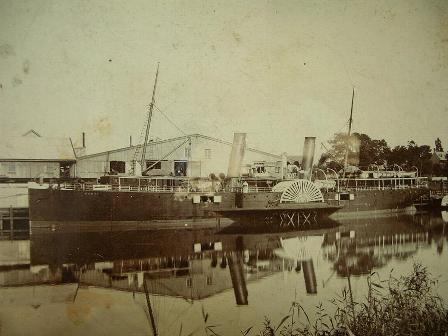
Left: SS Namoi.
Upon arriving at Newport the Sydney visitors were enabled to spend several hours ashore, picnicking, fishing, gathering flowers, or enjoying a stroll along the cool avenues which branch off in many directions from Hodge's Newport Hotel.THE HAWKESBURY RIVER. (1890, November 11). The Sydney Morning Herald (NSW : 1842 - 1954), p. 5. Retrieved from http://nla.gov.au/nla.news-article13798013
There is a lapse of almost nine years between the first appeal by the communities representatives to the Department of Public Works and the tenders for and construction of a public wharf at Newport that's more then a pier. One of the reasons is contained in this:
At a meeting at Newport on Saturday a resolution was passed stating that the time had arrived when Manly and Pittwater should be connected with North Shore by railway. Mr. Burns, M L A , said that between January and May of this year one Sydney company had booked as many as 5000 passengers to Pittwater on excursion days by one line of steamers. The present population of Manly was about 4500, Whilst the population of North Shore that would contribute traffic totalled 18,000. At present the passenger traffic to Manly amounted to upwards of 800,000 per annum and this would be largely increased by an efficient railway service.
A well attended meeting in advocacy of a line of railway from North shore to Manly and Pittwater was held at Newport on Saturday afternoon. Resolutions were passed all stating that the time had arrived when such a line should be built, and an executive committee was appointed to co-operate with tho North Sydney, Manly, and Pittwater Railway League in agitating the claims of the districts to railway communication. The meeting was attended by Mr. Burns and Mr. Cullen, M.L.A The Sydney Morning Herald. (1890, June 23). The Sydney Morning Herald (NSW : 1842 - 1954), p. 4. Retrieved from http://nla.gov.au/nla.news-article13799842
As the tram service, rather then a train connection, took a few years longer and only ever ran to Narrabeen, what seemed like a good solution never came to pass. Mr Jeannerett passed away on 23rd of August 1898, ill for some months prior to then.
Almost nine years after the first appeal to 'modify' what was still called the Newport Hotel Wharf:
The following tenders were opened by the Tender Board of the Public Works Department yesterday :- construction of a wharf and approach at Newport, Pittwater, 4 tenders, G. Lawson lowest, £496, 13s 3d PUBLIC TENDERS. (1898, July 19). The Sydney Morning Herald (NSW : 1842 - 1954), p. 7. Retrieved from http://nla.gov.au/nla.news-article14148762
PUBLIC TENDERS. Tenders have been accepted for the following Public works - Miscellaneous -Wharf and approach at Newport, Pittwater, G Lawson (Camden Haven), £496, 13s 3d. PUBLIC TENDERS. (1898, August 23). The Sydney Morning Herald (NSW : 1842 - 1954), p. 3. Retrieved from http://nla.gov.au/nla.news-article14135457
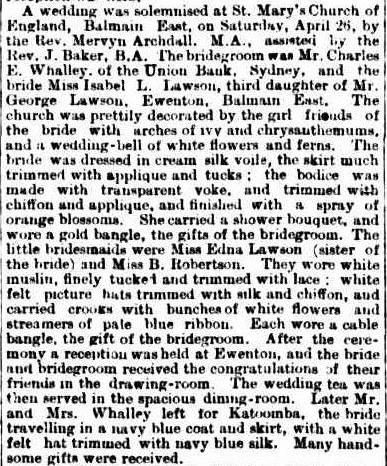 George Lawson was the Macleay River resident and third son of Christopher Lawson. Both are listed as shipwrights at Frederickton, Murwillumbah. George Lawson, who married Emily Ann Cheers in 1871, went on to have 11 children. He was renowned as a wharf and bridge builder from at least 1895 and many of the major and minor wharves on our eastern coast were built by him, as a contractor, during the years from 1895-1904. Soon after winning the contract to build a public wharf at Newport where the pier had once been, he moved his family to Ewenton, the rambling historical residence in Balmain and is recorded as living there until 1905. One of his daughter's had her wedding reception here (at right from): SOCIAL. (1902, May 17). The Sydney Morning Herald (NSW : 1842 - 1954), p. 7. Retrieved from http://nla.gov.au/nla.news-article14461102
George Lawson was the Macleay River resident and third son of Christopher Lawson. Both are listed as shipwrights at Frederickton, Murwillumbah. George Lawson, who married Emily Ann Cheers in 1871, went on to have 11 children. He was renowned as a wharf and bridge builder from at least 1895 and many of the major and minor wharves on our eastern coast were built by him, as a contractor, during the years from 1895-1904. Soon after winning the contract to build a public wharf at Newport where the pier had once been, he moved his family to Ewenton, the rambling historical residence in Balmain and is recorded as living there until 1905. One of his daughter's had her wedding reception here (at right from): SOCIAL. (1902, May 17). The Sydney Morning Herald (NSW : 1842 - 1954), p. 7. Retrieved from http://nla.gov.au/nla.news-article14461102
Harbour and River Works -Repairs to wharf and approach at Careel, Pittwater, George Lawson, Balmain, schedule works. PUBLIC WORKS TENDERS. (1899, April 18). The Sydney Morning Herald (NSW : 1842 - 1954), p. 3. Retrieved from http://nla.gov.au/nla.news-article14209738
Erection of wharf at Gladstone, Macleay River, G. and T. Lawson, £449. Public Works Tenders. (1891, January 10). Australian Town and Country Journal (NSW : 1870 - 1907), p. 42. Retrieved from http://nla.gov.au/nla.news-article71247840
Harbours and River Works: -Construction of a wharf and approach at Blackwall, Brisbane Waters George Lawson, Balmain. Est £391. PUBLIC WORKS TENDERS. (1901, March 20). The Sydney Morning Herald (NSW : 1842 - 1954), p. 5. Retrieved from http://nla.gov.au/nla.news-article14352625
The Following tenders have been accepted: Construction of timber beam bridge over Teven Crook, on road, Alstonville Booyong road to Teven Junction, George Lawson,' Balmain East, £597. No title. (1904, February 27). Clarence and Richmond Examiner (Grafton, NSW : 1889 - 1915), p. 4. Retrieved from http://nla.gov.au/nla.news-article61402254
TWEED RIVER – MURWILLUMBAH Mr George Lawson aged 66 years, well known in the Northern Rivers District as a bridge and jetty contractor, died today. TWEED RIVER NEWS. (1914, February 23). Northern Star(Lismore, NSW : 1876 - 1954), p. 5. Retrieved from http://nla.gov.au/nla.news-article72290851
George Lawson, 68, farmer, of Dungay, died last week. Deceased, who had been ill about four months, leaves a widow and an adult family of 11 children. Lawson was a native of the Macleay River, and resided there for about 35 years. PERSONAL. (1914, February 26). Clarence and Richmond Examiner (Grafton, NSW : 1889 - 1915), p. 4. Retrieved from http://nla.gov.au/nla.news-article61625285
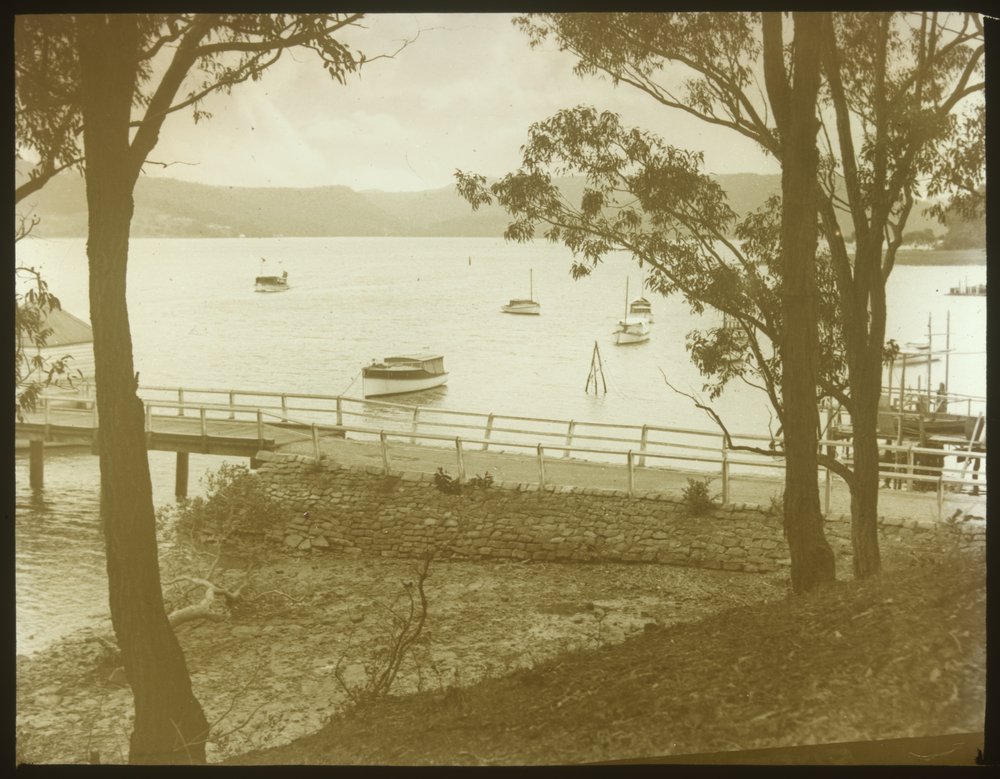
Hawkesbury River at Newport, N.S.W. by John Henry Harvey 1855-1938. [ca. 1880-ca. 1935]Image H91.300/505, courtesy State Library of Victoria
Fortunately, by 1906, Pittwater wharves were overseen by the brand new Warringah Shire Council and road improvements in Newport, new water troughs beside new water pumps, and the widening and grading with blue metal, some contracted out to George Boulton in 1907, begin appearing in their initial Minutes records. The lands around the Newport wharf, as with other reserves, were still owned by the State Government for which the new council paid rates. The water rights were also owned by State Government up to high tide mark and this initially restricted development or improvements for structures from these lands and into these waters for which they were responsible. Warringah Councillors, contacted regularly by Newport Progress and Scotland Island Community Groups for improvements to dirt roads, or by proprietors, underline community involvement from the first instance.
During Autumn, Spring, and Winter the steamers, with Pittwater SS Phoenix among them, kept coming, for decades - the other important use of the wharf, which is still current - was that of being able to transport children safely to school - see: : The Newport School 1888 to 2016 and To School and Home on the Ferries - Australia's First School Launch was in Pittwater
HOLIDAY: Excursions to Hawkesbury River and Pittwater rill be run by the Newcastle and H.R.S.S. Co.,limited. The Namoi will go to Cowan Bay, and Also about five miles up Cowan Creek, and the Archer to Newport, each leaving the Market-street wharf at,10a.m. EXCURSIONS FOR THE DAY. (1902, October 6). The Sydney Morning Herald (NSW : 1842 - 1954), p. 8. Retrieved from http://nla.gov.au/nla.news-article14505760
Woy Woy for Hawkesbury River, Newport, and Pittwater, from Russell’s Wharf, + Kallawatta, for Hawkesbury River, Newport, Pittwater, and Mangrove PROJECTED DEPARTURES.—May 19. (1911, May 19). The Sydney Morning Herald (NSW : 1842 - 1954), p. 8. Retrieved from http://nla.gov.au/nla.news-article15210325
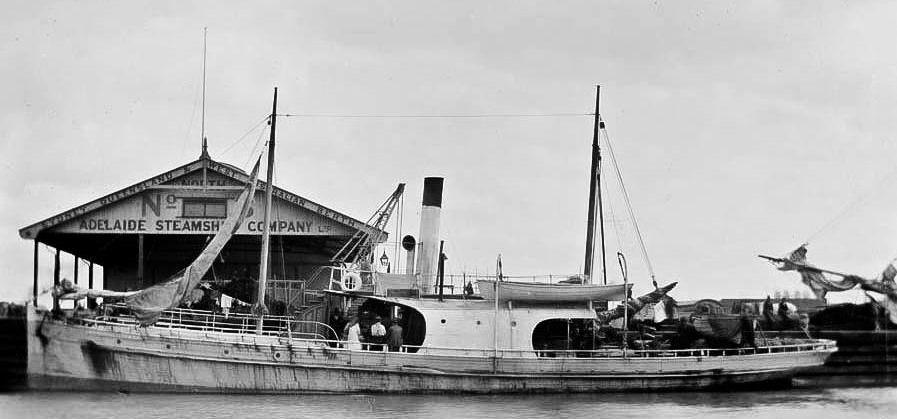
HAWKESBURY RIVER. BAYVIEW, PALM BEACH, PITTWATER, NEWPORT, ETC. S.S. CHARLOTTE FENWICK leaves Monday, 6 p.m. Thursday', 5 p.m. From Macleay Shipping Co.'s Wharf, Barker-street, off Bathurst-street Tel.. City 1018. HAWKESBURY S.N. CO.-S.S. ERRINGHI. Every Tuesday and Friday, from Albion Wharf. All Ports, including Bay View, Palm Beach, Pittwater, Newport, etc Cargo received daily. Tel.. City 1838. HAWKESBURY RIVER and PITTWATER, all Wharves and Branches.-Kallawatta, 4 p.m. Today. Cargo received early, Bathurst-st 'Ph., City 7Q5 Advertising. (1919, September 12). The Sydney Morning Herald (NSW : 1842 - 1954), p. 1. Retrieved from http://nla.gov.au/nla.news-article15853818
Warringah Shire Council began excercising control over the much used wharf, doing what it could as it could: Hays & Miles, launch Proprietors, Newport, again complaining of unfair treatment by Agar Bros. Resolved, - (councillors Quirk, Campbell) That, with a view to the Council exercising more direct control over the Newport Wharf the proprietors of each ferry service be requested to submit timetable.15/3/20
Newport Wharf 4. Resolved, - (Crs. Simpson, Hope) That £7 extra be voted vote for the lavatories to be built on Newport Wharf 27th Sept. 1926
Government Tourist Bureau. 2/5/27. Advising that it has no funds for the subsidising of public conveniences at Newport Wharf. Received.
20. Chas. Johnson,. 20/11/28. (1) Reporting that a dangerous hole exists in the planking on Newport Wharf, also reporting that one of the wooden girders on the outside of the wharf has gone, and (3) requesting that the promised improvement of the road to the wharf be carried out before Christmas. To be furnished with a copy of the Overseer's report on the matter. . .
2. Land Board Office. 12.3.30. Inquiring whether there are any objections to the granting of J. H. Wheat's Special application for a Special Lease below highwater-mark close to Newport Wharf. Referred. to Works Committee.
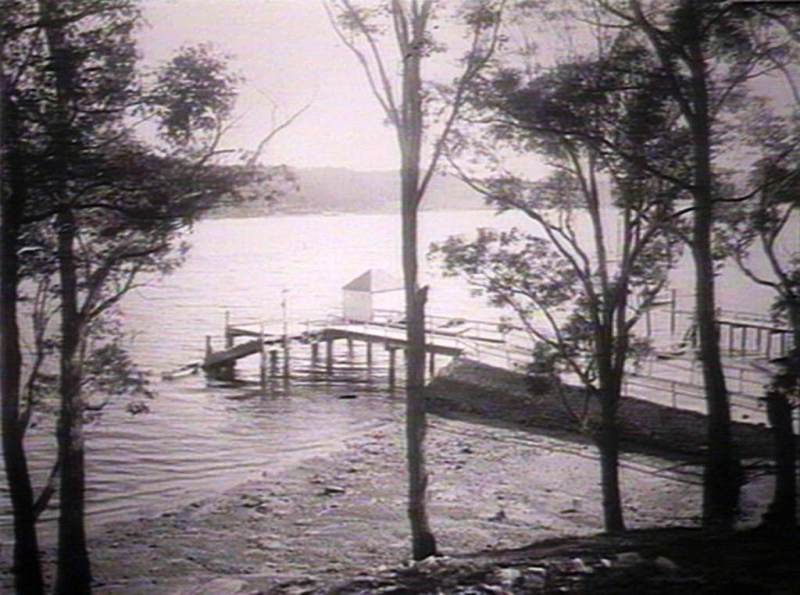
Newport - "Government Public Wharf, photo taken June 1925. Image d-15925-H, 'Govt. Public Wharf - Newport. Courtesy State library of NSW
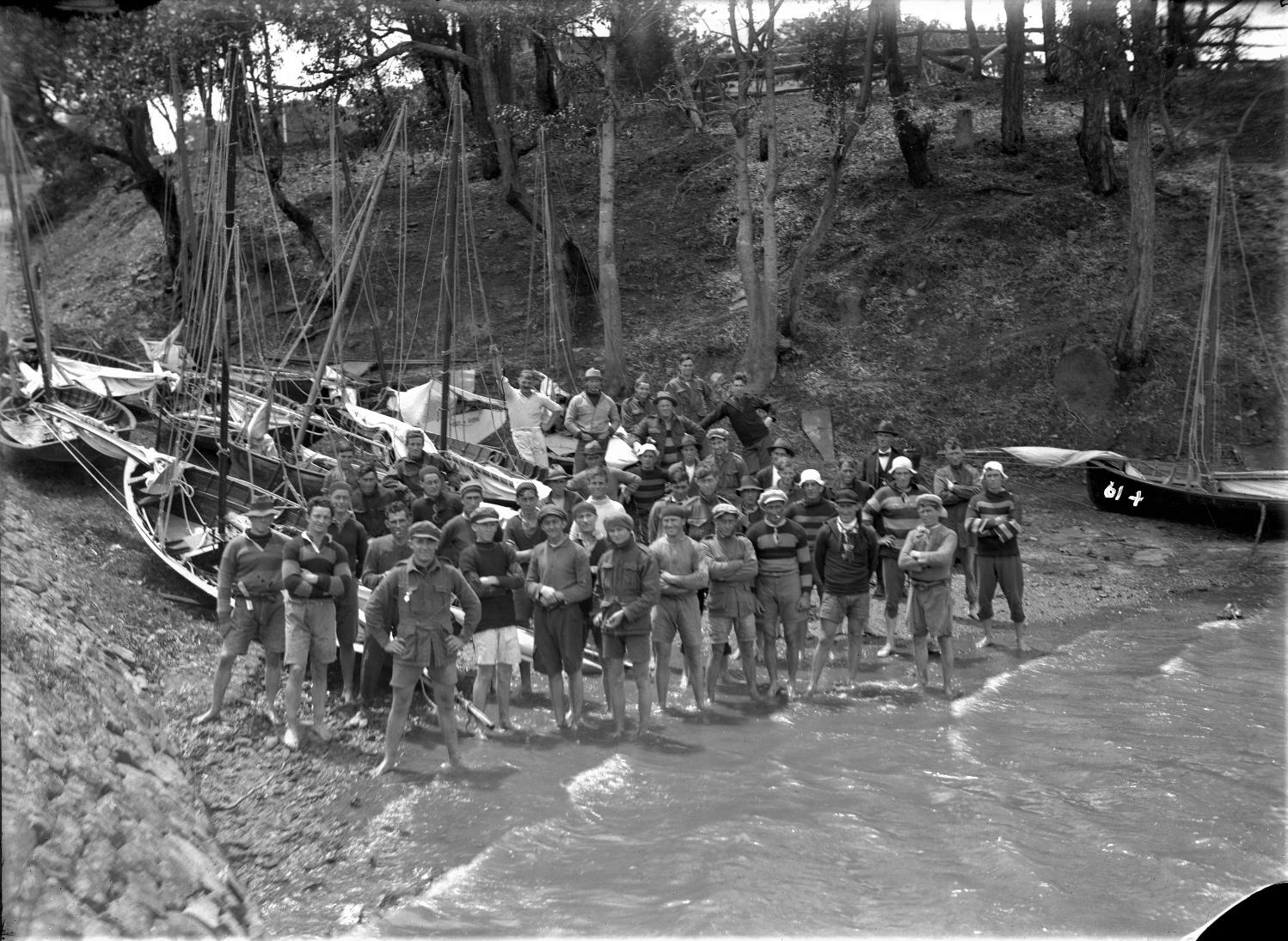
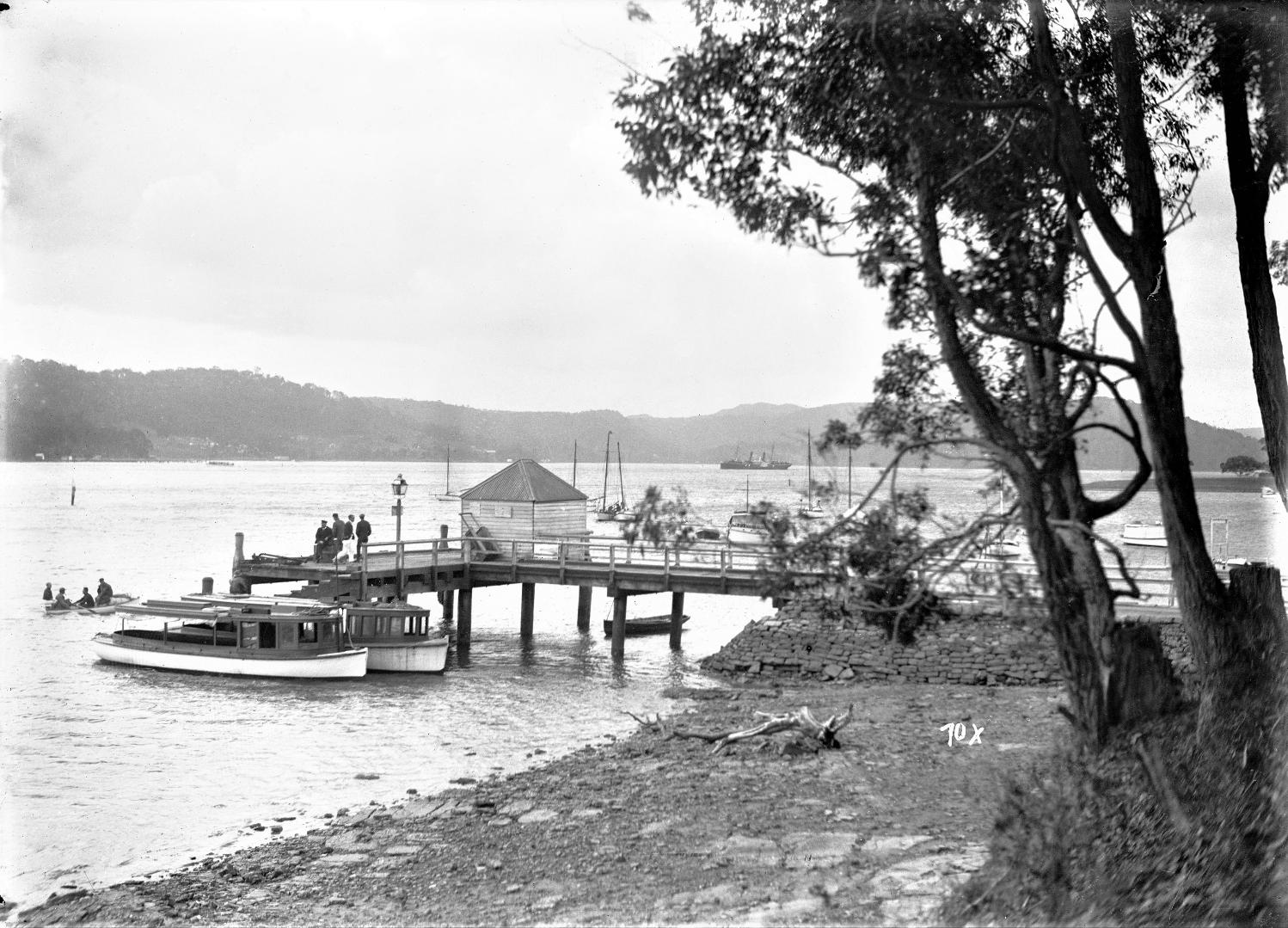
During the 1930's, with people camping in every possible reserve and Warringah Council reducing or waiving completely some fees for these people on their request, with the drop in 'excursionists' coming to spend their shillings in Pittwater, wharfage fees and all associated funds dwindled. Those with a bit of get up and go to start and expand new businesses were supported. One of these used Newport Wharf (7. all from Warringah Shire Council Minutes):
56. Pittwater Shell & Lime Co. Ltd., 11/9/35, stating the Company is prepared to contribute one half of the cost of repairing the Newport wharf up to a maximum of £75, provided the Company may have the free use of it during usual working Wharf hours, and provided the Council has no objection to the Company establishing a lime burning works in the Brookvale district; suggesting the Council's Engineer confer with the Company's Engineer on the matter. Resolved, - That the Shire Engineer confer with the Company's Engineer on the matter, and if he is satisfied with the terms, this Council join with the Company on a 50/50 basis, up to a inc.l sum of £75, in repairing the wharf, (Crs. Hughes, Campbell)
57. Pittwater Shell & Lime Co.Ltd., re proposed operations of Company at. Newport wharf, and requesting permission to instal submerged hoppers between the end of the wharf Newport the main approach thereto; (b) to erect a bin 20' xl0' x 15' on the shore and between the causeway and the public lavatories; and (c) to run two beams from the approach to the end of the wharf. Already dealt with. 10/12/1935
Pittwater Shell &Lime Co. Ltd., 6/3/36, applying for permission to connect the water service from the main on the Newport road at Newport, extending along Queens Parade, and connecting with the bin adjacent to Newport wharf. Resolved - That permission be granted.
Parks &. Playgrounds Movement, 28/4/36, requiring certain information regarding hopper near Newport wharf - whether erected with permission of Council, whether under lease, and whether upon a public roadway. "Received"
Land Board 0ffice 23/10/36, inquiring by whose authority certain structures, comprising storage bins, conveyor and mooring piles, have been erected below highwater mark adjoining the
Newport wharf fronting Queens Parade, and if unauthorised, whether the Council has any objection to stops being taken to legalise the occupation. Resolved, - That the Department be informed of the facts, and that the Council has no objection to a Permissive Occupancy being granted. (Crs, Campbell, Hewitt).
T H Wheat requesting permission to improve and extend the boat shed on his lease at Newport wharf in accordance with sketch submitted. (Dealt with in Building Committees report) 27/7/1937
Denver Trading Pty. Ltd., 12/2/40, further re Company's dredging operations in the vicinity of Bayview Park, (a) requesting permission to erect storage bins with conveyor and elevator immediately, it being the Company’s proposal to transfer from Newport wharf the bins owned-by Pittwater Shell and Lime Company, requesting Council's decisions regarding Dredging proposals previously submitted by Company, viz (b) to operate for five years; (c) to enclose a small portion of Bayview Park for the protection of the Company's plant; (d) to reclaim portion of the Park free of cost to the Council, and to enclose a neighbouring portion at a remuneration on a yardage basis to be agreed upon. Same, 16/2/40, on same matter, and stating Company will fill in the area approved by the Shires Engineer without cost to the Council. Resolved, - That the Works Committee again inspect the area and meet representatives of the Company there for the purpose of discussing the whole of the proposals.
Reporting on works in hand or completed during the past fortnight: Resolved, - That the report be "received"; that Wharf repairs be effected to Newport Wharf as a maintenance-job, and that in regard to Bayview wharf, a sign be erected, pending the repairing of the wharf, that persons using the wharf in its present condition do so at their own risk. (Crs. Hitchcock, Nixon) 22/12/1942
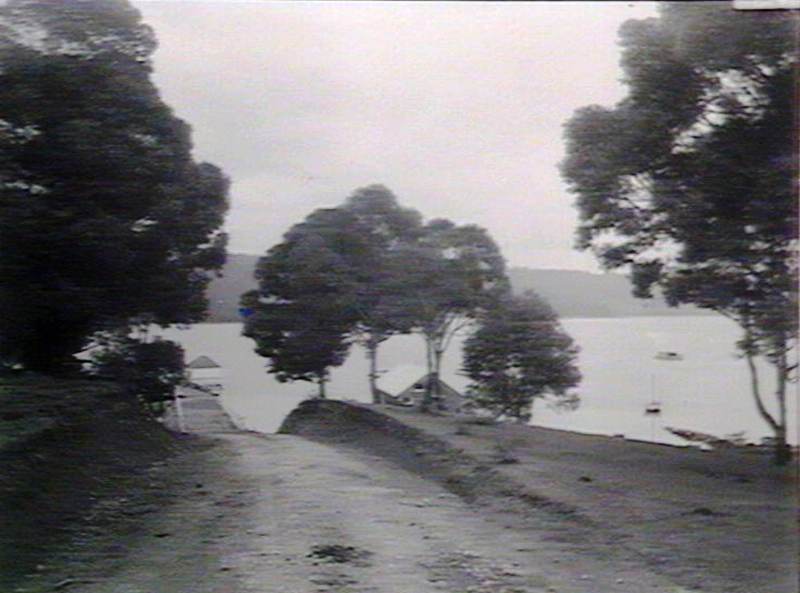
Newport Wharf road, June 1925. Courtesy State Librray of NSW. Image No: d1-12322h
During the 1950's another reconstruction of the Newport Wharf, which ended in costing 2600 pounds, more then a fair amount then had to be found by Warringah Council:
Public Works Department, 3/4/52, stating that careful consideration has been given to the Council's application for assistance towards the cost of reconstructing the Newport public wharf at Queen's Pde. Newport, but it is not considered that the circumstances are such as to warrant subsidy of the work by the Government. 22. Resolved: That the letter be received, and the Engineer prepare an estimate of the cost of reconstructing the Newport Wharf, for consideration with the next estimates. (Crs. McKay, Beach).
5/9/55. 26127(B) Scotland Island Progress Association: (1) Thanking Council for the prompt completion of the cargo staging at Church Point; (2)trusting that the matter of clearing the foreshores reserves will be given further consideration when opportunity permits; (3)stating that a suggestion has been made that Council has not assumed full legal ownership of these reserves and strongly recommending that this be done; (4) as the poles adjacent to Newport wharf were removed by order of the Public Works Department recommending that consideration be given to providing mooring facilities similar to those formerly in the area. Resolved - (1) "Received and noted. (2) Referred to the Works Committee. (Crs. McKay/Corkery). (3) Referred to the Legal Officer. (Crs. NcKay/Gwynne). (4) Referred to Maritime Services Board as the appropriate Authority. (Crs. McKay Simonds).
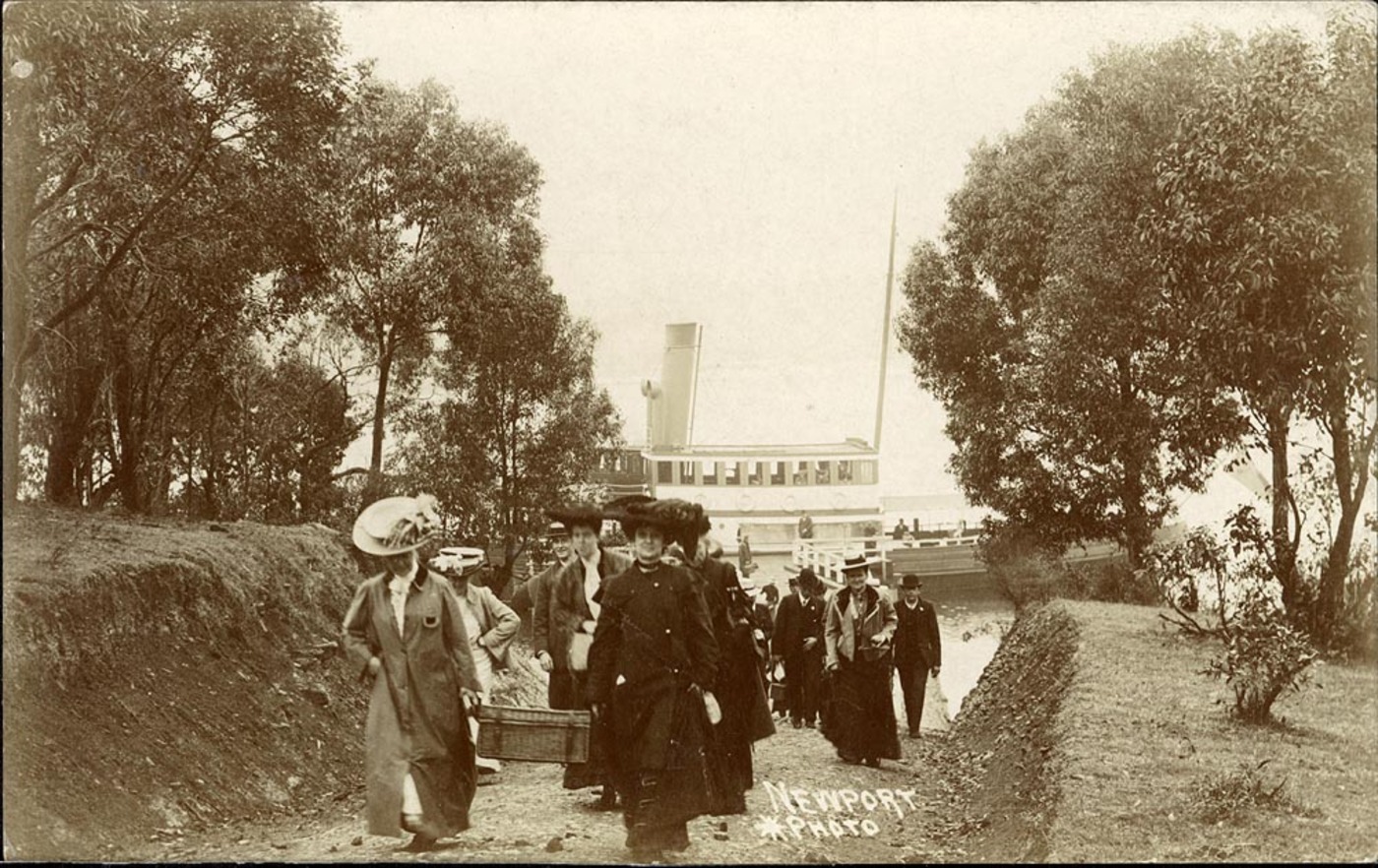
Disembarking at Newport for picnic, circa 1900 (Ferry is the SS Phoenix), 'Newport Wharf '- by Sydney & Ashfield : Broadhurst Post Card Publishers from album: Scenes of Newport, N.S.W, Image No: , curteys State Library of NSW
Maritime Board 15/9/55, replying, in regard to the representations of the Scotland Island Progress Association for moorings near Newport public wharf, that whilst matters relating to the registration and control of mooring sites on navigble waters are administered by-the Board under the provisions of the Mooring Regulations, N.S,W. it is not the Wharf policy of the Board to provide facilities of this type for the mooring of vessels. Resolved, - That a copy of the letter be sent to Scotland Is. Progress Association for comment, and a report be furnished regarding the question of improvements to Newport Wharf. (Crs. Jones, Gwynne)
Scotland Island Progress Association, 29/9/55, replying in connection with representations for reconstruction of the "dolphin" adjacent to Newport Wharf, stating this was used by small craft for temporary mooring only, and contributed to keeping the wharf clear of moored craft that the Association cannot understand why the Public Works department requested the removal of the dolphin nor which authority was responsible for its original construction, and contending that as it is complementary to the public wharf its construction and maintenance might reasonably be assumed to be the responsibility of the authority controlling the wharf and therefore recommending that the Council erect and maintain a dolphin the vicinity of Newport public wharf and restrict it for temporary mooring of small pleasure craft. Resolved, - That this matter be referred to the Works Committee for consideration, following an inspection.- (Crs. McKay, Fisher)
Newport wharf Repairs: on the motion of Cr. McKay end seconded Cr. Hewitt, that the estimate submitted by the Engineer for repairs to the Newport Wharf be approved and that the work be proceeded with immediately.9/4/1956
8/101956: Newport Wharf Reconstruction 2,600.00
Report to Ordinary Meeting, 15th December 1980 2.2 PUBLIC WAITING SHED - NEWPORT PUBLIC WHARF (File: 446/16) Council resolved, on 11/11/1980 (Minute No.1357) that a more detailed report concerning the above proposal be furnished. Mr B. Gray, proprietor of Boatshed Cruises, a floating boat restaurant, wishes to upgrade facilities at the main departure point of the Newport public wharf. The facility proposed includes an all weather public waiting shed and an adjoining booking office. It would be located at the end of Newport Wharf for the benefit of the firm. Mr Gray is prepared to cover construction and maintenance costs of this facility. The applicant has written to the Minister of Tourism, Mr K. Booth, requesting that Boatshed Cruises be granted a Permissive Occupancy lease on the booking office. Mr Gray has proposed construction of a waiting shed and booking office of dimensions 8m long x 4.5m wide on an extension to the north side of the Newport Wharf. Existing timber piles are proposed to support the structure but an investigation by the Engineering Department has revealed that the existing piles should be replaced. An estimated cost of installing four timber piles, together with timber supports decking, roof and cladding is $9,000. The Land Board Office has written to Council advising that an application for Permissive Occupancy has been. received from Boatshed Cruisers and, in consequence, has requested Council's advice as to its concurrence or otherwise to the granting of the Permissive Occupancy. The proposal was considered by Council’s Property Management Panel, which recommended (11/11/1980): "1. That the applicant be advised that Council is unable to accede to the request for the proposed facilities because the facilities which are proposed are of a commercial nature on public land. This is considered unacceptable. 2. Council give consideration to the provision of a waiting shed on Newport Public Wharf in the 1981 Estimates." Statutory Environmental Planning Requirements: The proposed development will require the lodgement of a development application and planning consent of Council under Clause 59 of the Planning Ordinance. Furthermore, the consent of the owner of the land, namely the Lands Department (being Crown land below high water mark), would need to accompany such application. Justification and Merits of Proposal: On the merits of the matter, there is no objection to the erection of a public waiting shed on the public wharf.
This review, which has also been publicly exhibited, identifies the Newport Wharf/Hotel precinct as one that has potential to provide additional tourist accommodation close to the existing hotel, wharf and water way, it also recommends that existing waterfront businesses operating with existing use rights, be rezoned 3(b3). Andersons Newport Boat Services is one such business which has been identified for a possible 3(b3) zoning even though It occupies unzoned land below mean high water mark. Therefore, this application is not In conflict with the recommendations of this LEP review. 6/9/1989
13/2/1990: Minor rezonings are also proposed in respect of the Palm Beach Wharf Area, where it is proposed that part of the Existing Foreshore 6(a) Recreation zone should be rezoned to facilitate a bus/ferry interchange and ancillary facilities as recommended in the Pittwater Plan of Management Study. It is also recommended that the existing Neighbourhood Business zone in the Newport Wharf /Hotel locality be extended to facilitate tourist facilities and an expansion of residential flat buildings. However, the Study has not indicated the extent of the proposed zoning changes.
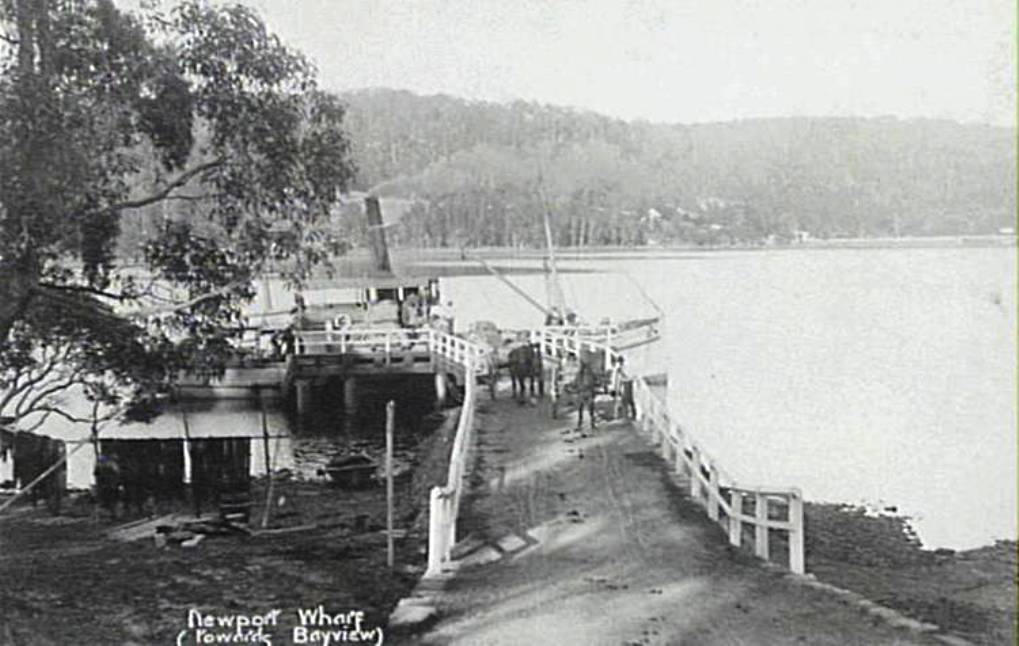
Newport Wharf 1900. C/- Isobel Bennett and Pittwater Historical Images at Mona Vale Library.
Today the Newport Public Wharf is still a place for children to disembark on their way to Newport School, transported there by the Church Point Ferry Service.
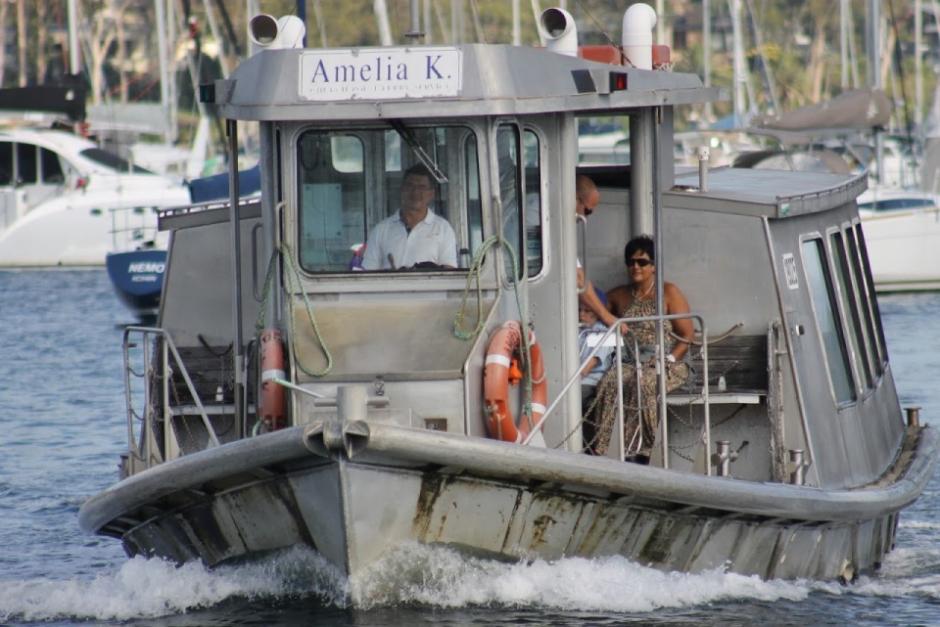
Church Point Ferries Ferry Master Ian (aye aye Captain!) on the Church Point to Newport School Ferry Run
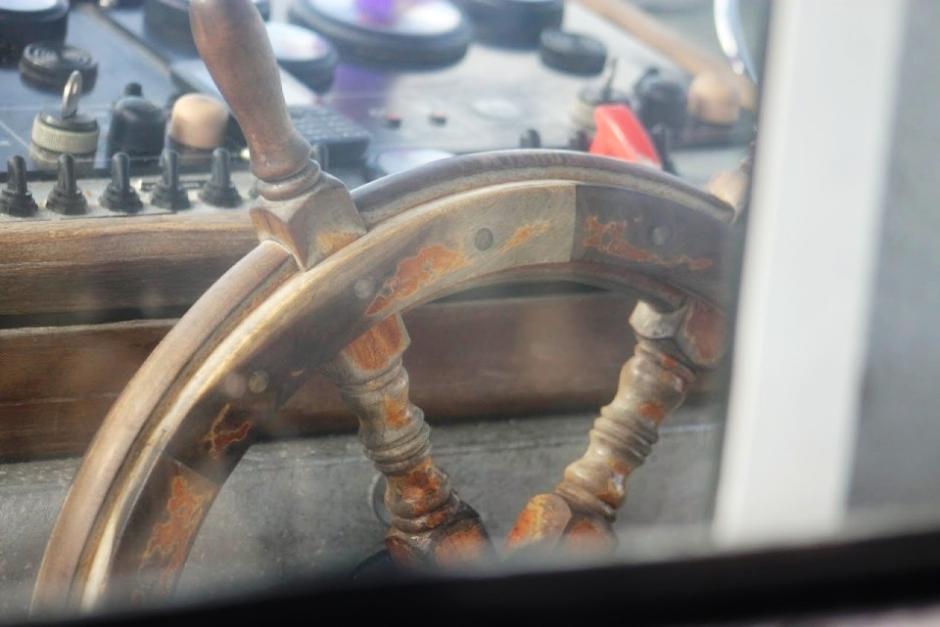
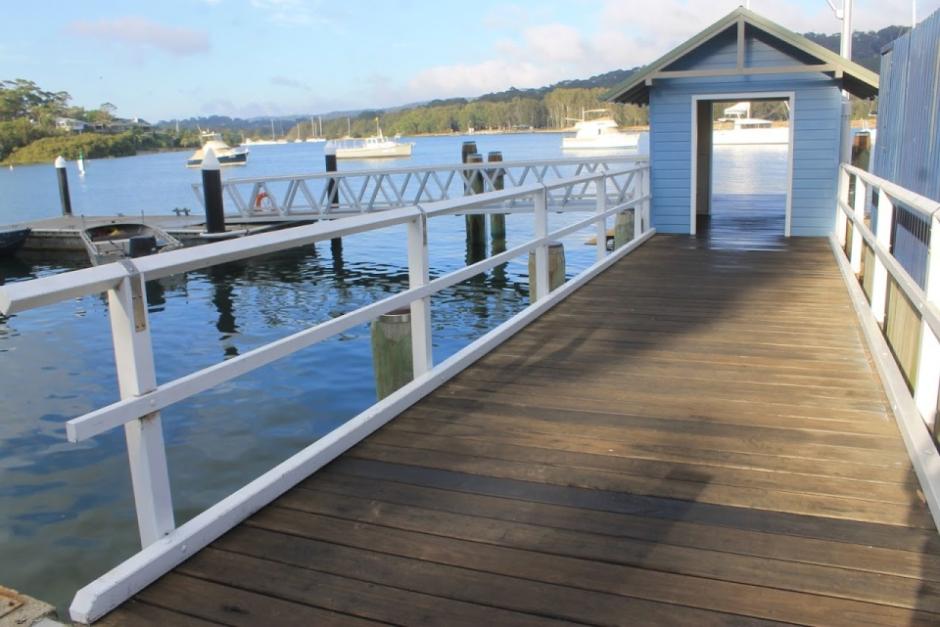
Newport Public Wharf - view to Winnererremy Bay
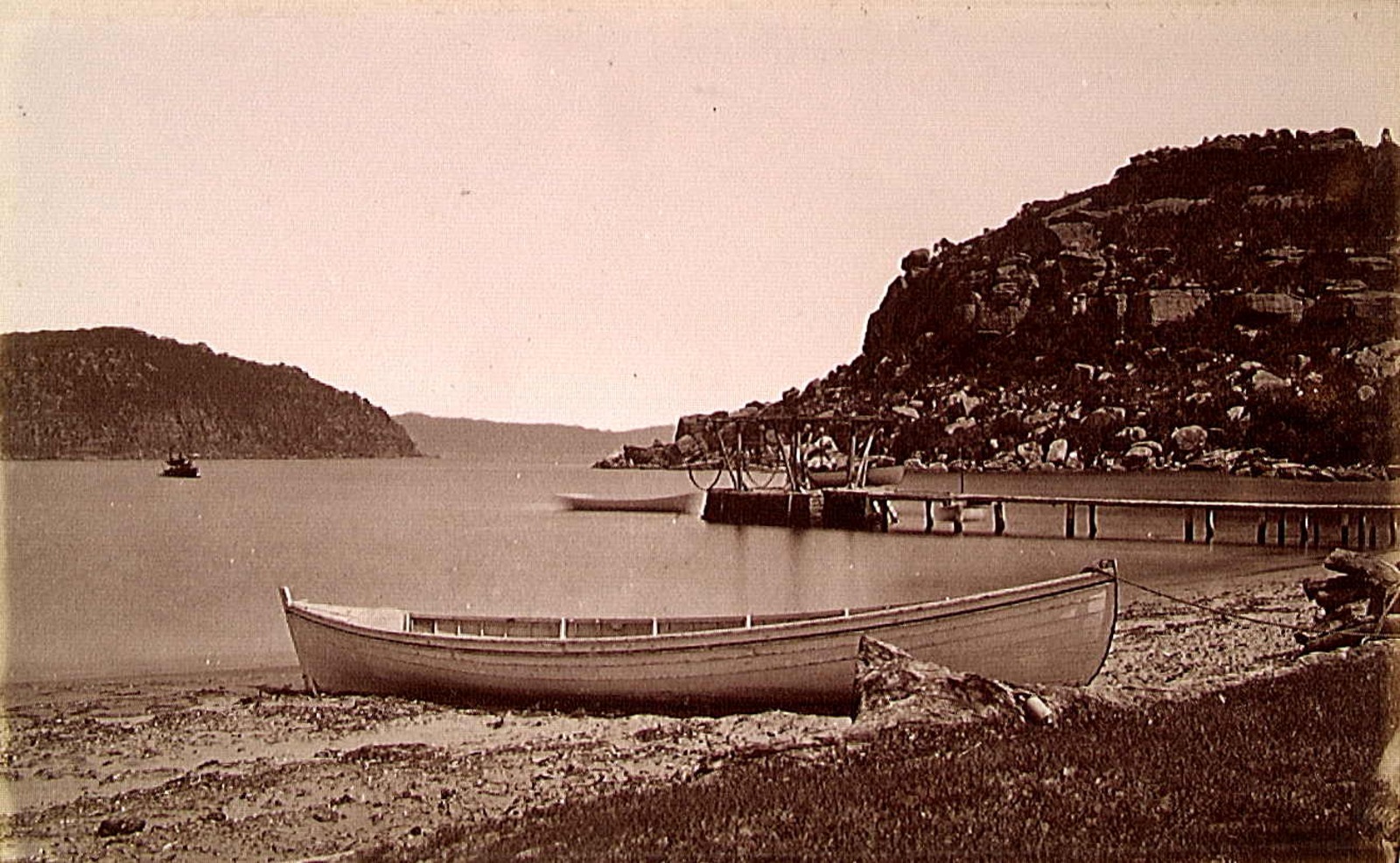
Broken Bay. Date(s) of creation:1889. by Charles Potter 1889. Image No:FL15796563. Courtesy State Library of Victoria
References - Extras
- Her Majesty Queen Elizabeth II - A Tribute Of Local Connections
- The First Royal Visitor To Australia: The Incident At Clontarf; March 12th, 1868
- Pittwater Roads II: Where The Streets Have Your Name - Newport
- The Newport School: 1888 To 2018
- Trafalgar Square, Newport: A 'Commons' Park Dedicated By Private Landholders - The Green Heart Of This Community
- Photographers Of Early Pittwater: Charles Bayliss
- Broken Bay Customs Station At Barrenjoey
- Albert Thomas Black
Description of Newport
Pittwater and the Hawkesbury Lakes
From: Brees, Harold & S.T. Leigh & Co & Mills, Pile & Gilchrist. (1880). The Pittwater and Hawkesbury Lakes album Retrieved from http://nla.gov.au/nla.obj-460123425
The road to Newport, after leaving Manly, crosses the Curl Curl Lagoon, on a solid embankment about twenty feet in width and half a mile in length. It then passes along the northern side of Curl Curl Creek for a mile or so, leaving a splendid rich country belonging to the Bassett Darley Estate, to the left. At the head of the Creek can be seen a range of steep hills—about six hundred feet in height—clothed in vegetation to their tops. The swamps between these hills contain a large and unfailing supply of water at a sufficient elevation to be easily conducted by gravitation to almost every house in Manly.
Dewhy Lagoon, a beautiful sheet of water of about 100 acres in extent, is about four miles from the Pier Hotel, and is only separated from the ocean by a narrow ridge of sand. This lagoon (like other sea-side lagoons) varies greatly in size from time to time, and like all the others its outlet is on its northern end. A succession of easterly gales heaps up the sandy barrier, and enables the rain waters from the mountains to increase to a great extent, until the accumulated water, through heavy rain, becomes too strong for the sandy barrier and bursts through to the ocean, leaving immense quantities of fish stranded on the beach.
Long Reef, a beautiful basaltic hill right on the coast, is the homestead of Miss Jenkins, whose family have been residents of this locality nearly half a century. The soil here is very beautiful, and the scenery grand beyond description, A fine vein of iron ore is exposed on the ocean beach, but it has at present no commercial value.
The Narrabeen Estate, the property of Mr. Wetherill, of Sydney, extends from Long Reef to Narrabeen Lake. It was once in cultivation, as can be seen by the plough-marks, and produced large crops of maize. The lake is a splendid sheet of water, generally about a mile in width, extending among beautifully wooded hills inland for a great distance, with wide navigable arms penetrating further into the valleys between the mountains. It is well stocked with fish, and there are some fresh water lagoons with abundance of silver eel. It is remarkable that this beautiful lake, so easily accessible, is so little known. Game abounds in the ranges to the west. As said before, fish is abundant, and being secure from sharks, and of even depth for long distances, it is the safest and in every sense the best place for a long swim near Sydney. Should Mr. Wetherill subdivide his Estate, and a good hotel be built, a new watering place will spring up on the shores of this enchanting lake, which will speedily become popular. The sketch herein is taken from the southern side, at the present crossing place, which will shortly be superseded by a bridge.
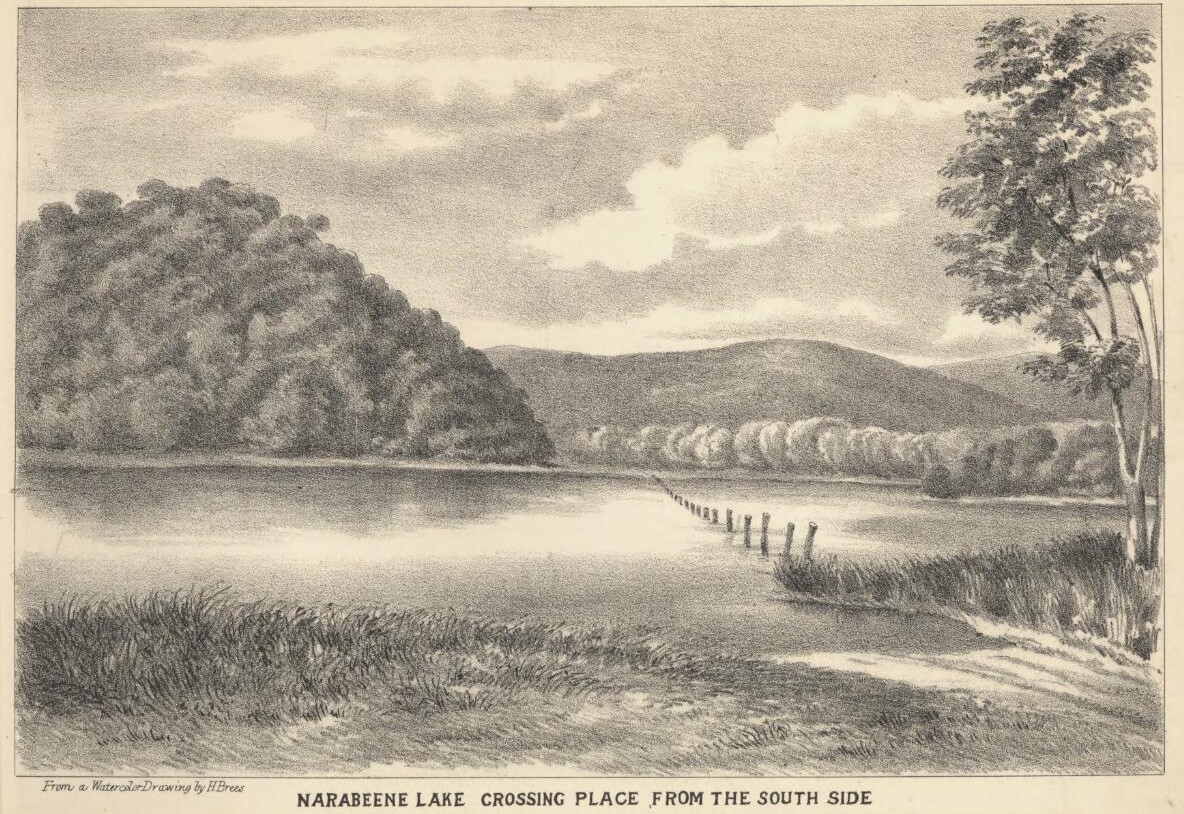
NARABEENE LAKE CROSSING PLACE FROM THE SOUTH SIDE
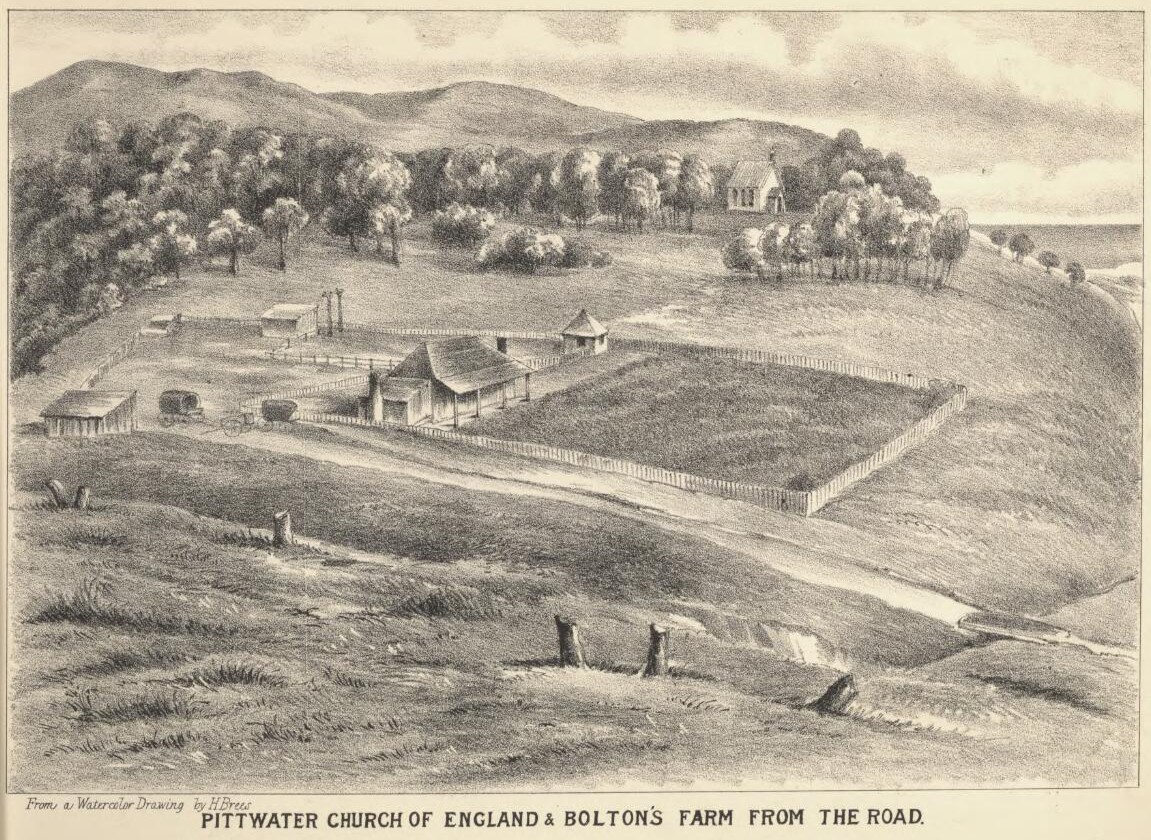
PITTWATER CHURCH OF ENGLAND. BOLTONS FARM FROM THE ROAD.
About a mile beyond Narabeen the road crosses a steep hill from the top of which the hills beyond Newport, as well as Lord Loftus Point, are distinctly visible, we next come to BOLTON’S FARM, the subject of an illustration. The soil of this locality is very rich, and it is rather strange that it is not cultivated.
The two next sketches—
THE GREEN HILL and THE OCEAN BEACH, are taken from where the road passes alongside a gap between two high hills close to Newport. They represent scenery which cannot be matched anywhere near Sydney.
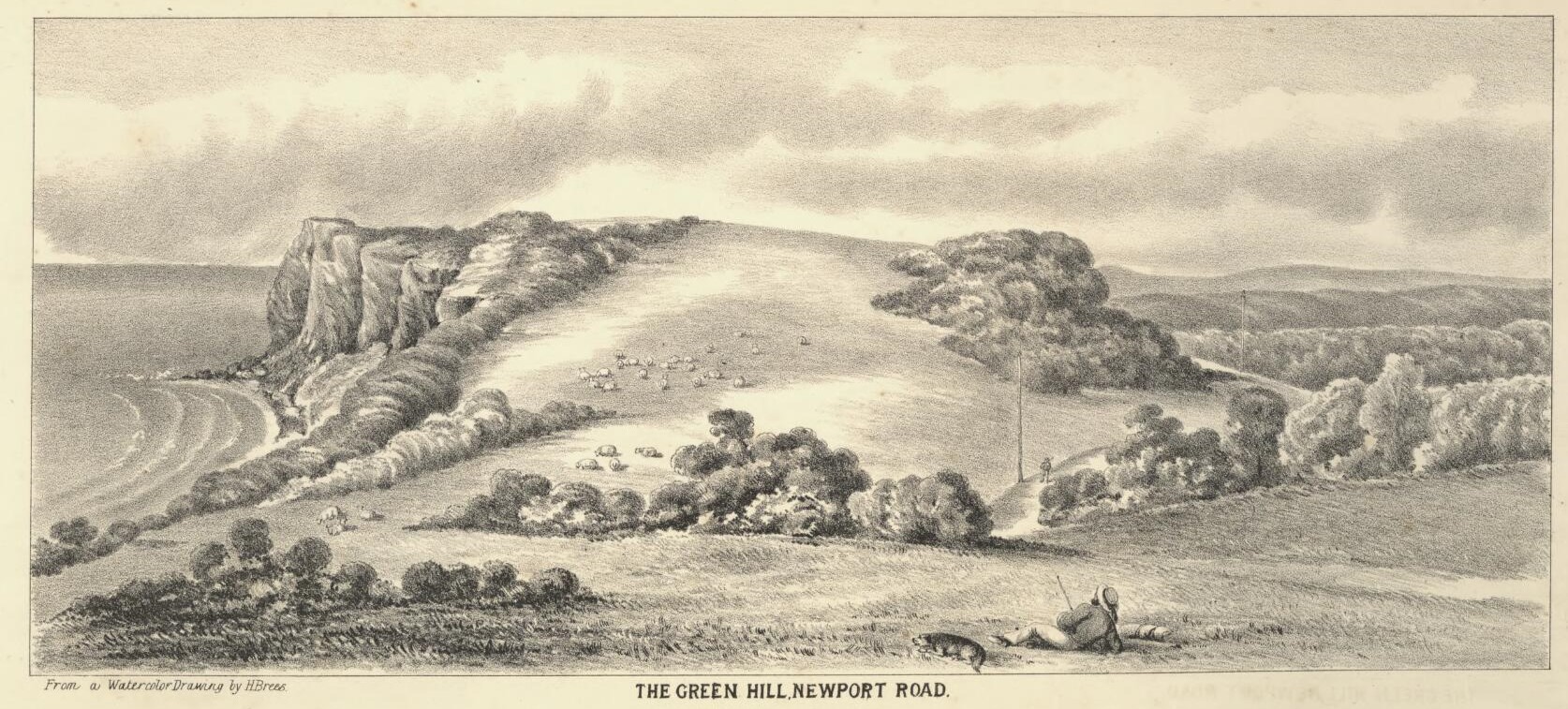
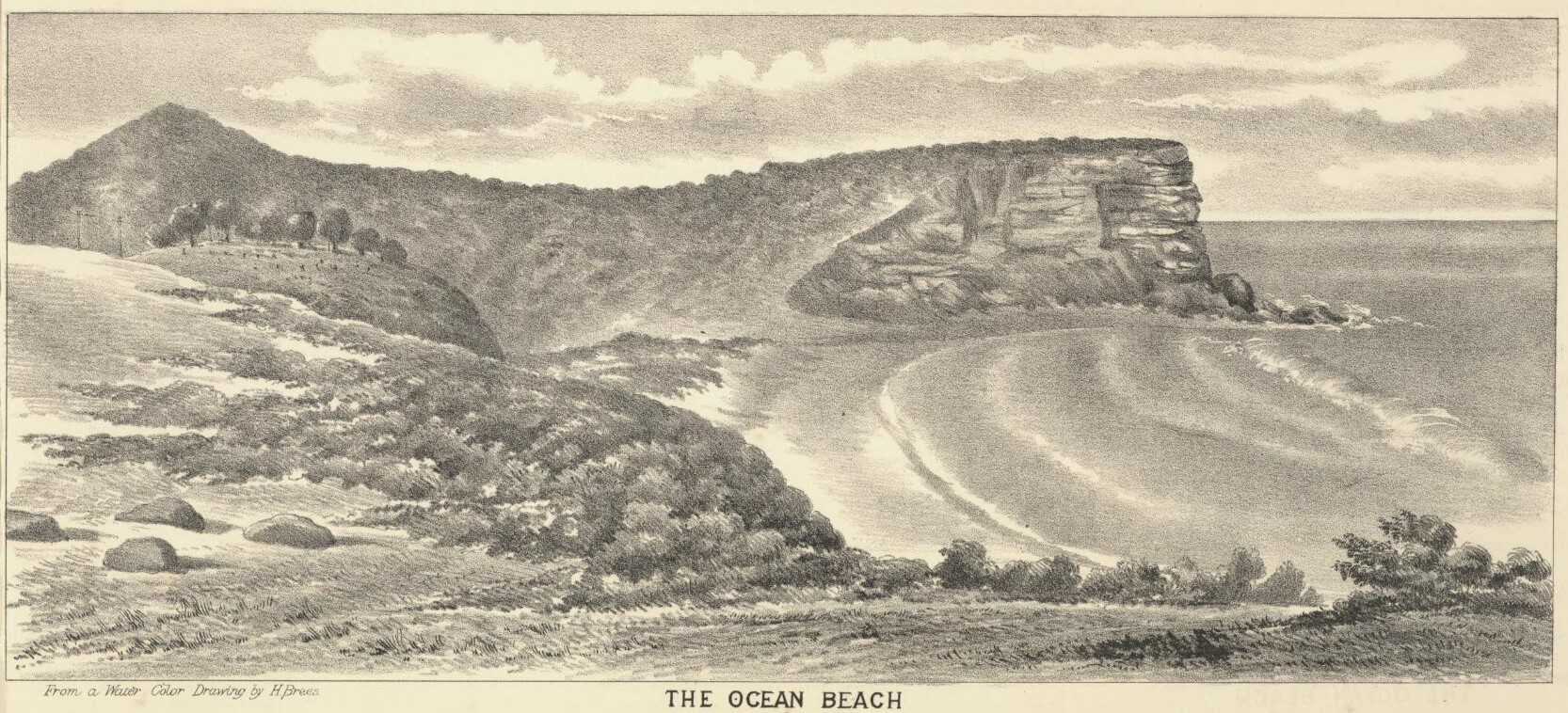
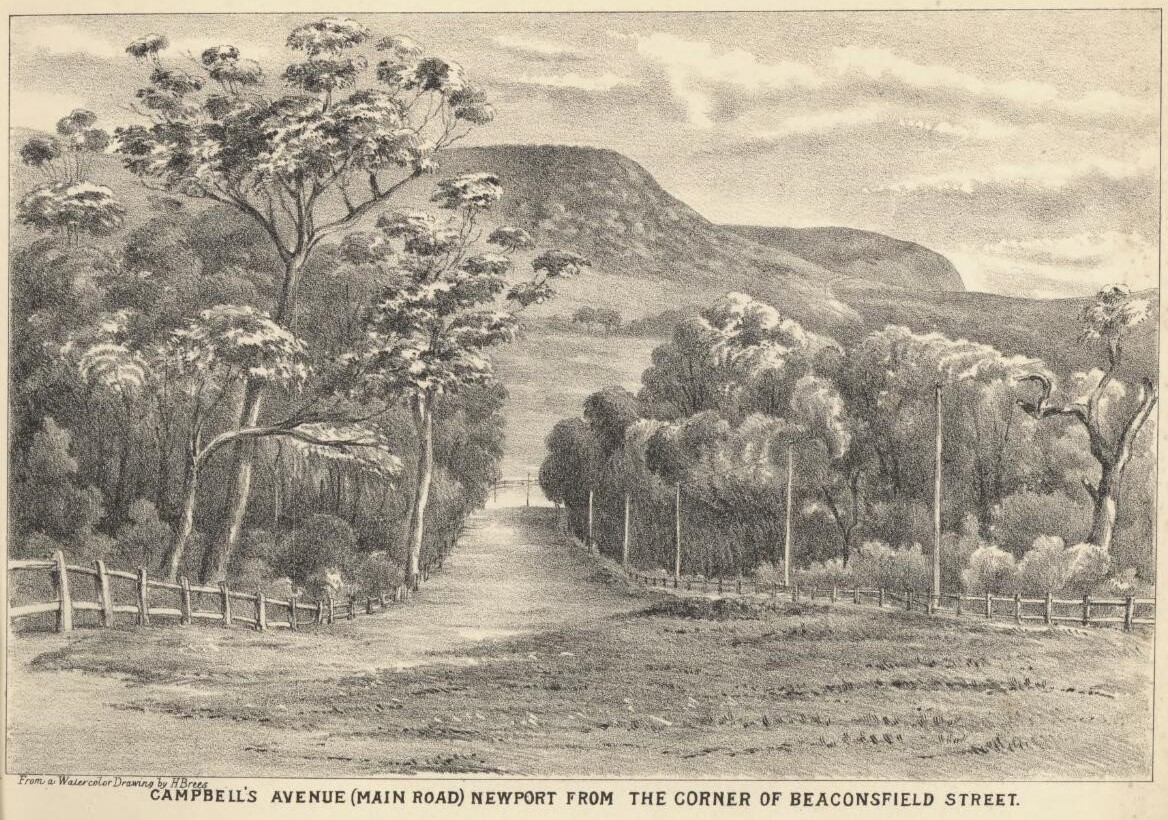
CAMPBELL'S AVENUE (MAIN ROAD) NEWPORT FROM THE CORNER OF BEACONSFIELD STREET.
Campbell’s Avenue is where the main road to Barranjoey bounds the town of Newport. The sketch is taken from the top of Beaconsfield-street. The cleared ground at the foot of the hill (Mount Loftus) is Mr. Farrell’s farm. The road to Careal and Barranjoey crosses the spur of the mountain close to the sea coast.
The town of Newport extends right from the main road to the shore of Pittwater about half a mile. It has been laid out on a grand scale, the allotments being mostly half an acre to three-quarters of an acre each. The main street (the Queen’s Parade) is one hundred and thirty-two feet in width, the other streets one chain. The deep-water channel of Pittwater passes the property right alongside the shore, and ends just above. The largest steamers can lie alongside the wharf at low tide. A spacious hotel has recently been built, the roads have been formed, and the steamers for the Hawkesbury and Brisbane Water make it their head quarters. Arrangements have been made to establish a Public School. A central site has been reserved for a post and telegraph office. A considerable trade has already sprung up, and as it is even now the centre of a very considerable population, the terminal point of an extensive system of river traffic, a favorite fishing locality, and a favorite place for yachting, and being more-over close to the ocean beach, Newport cannot fail to become very shortly a favourite watering place, and a town of considerable importance.
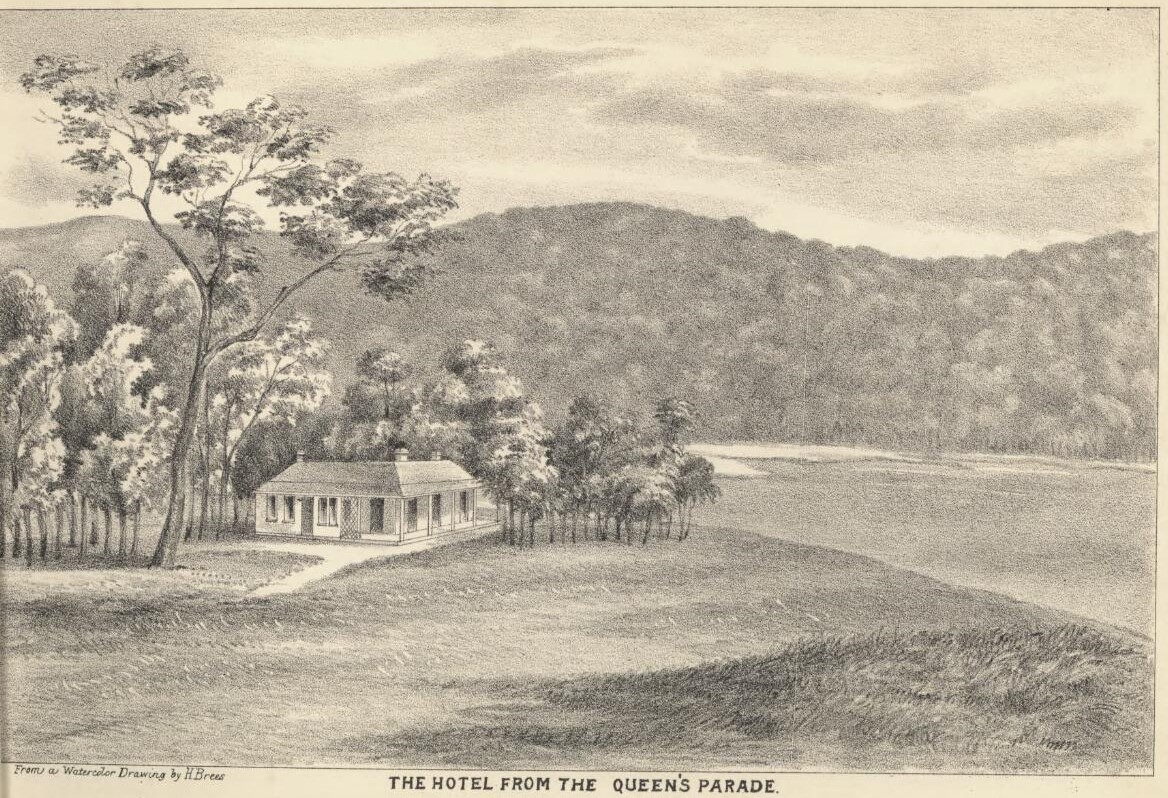
THE HOTEL FROM THE QUEENS PARADE
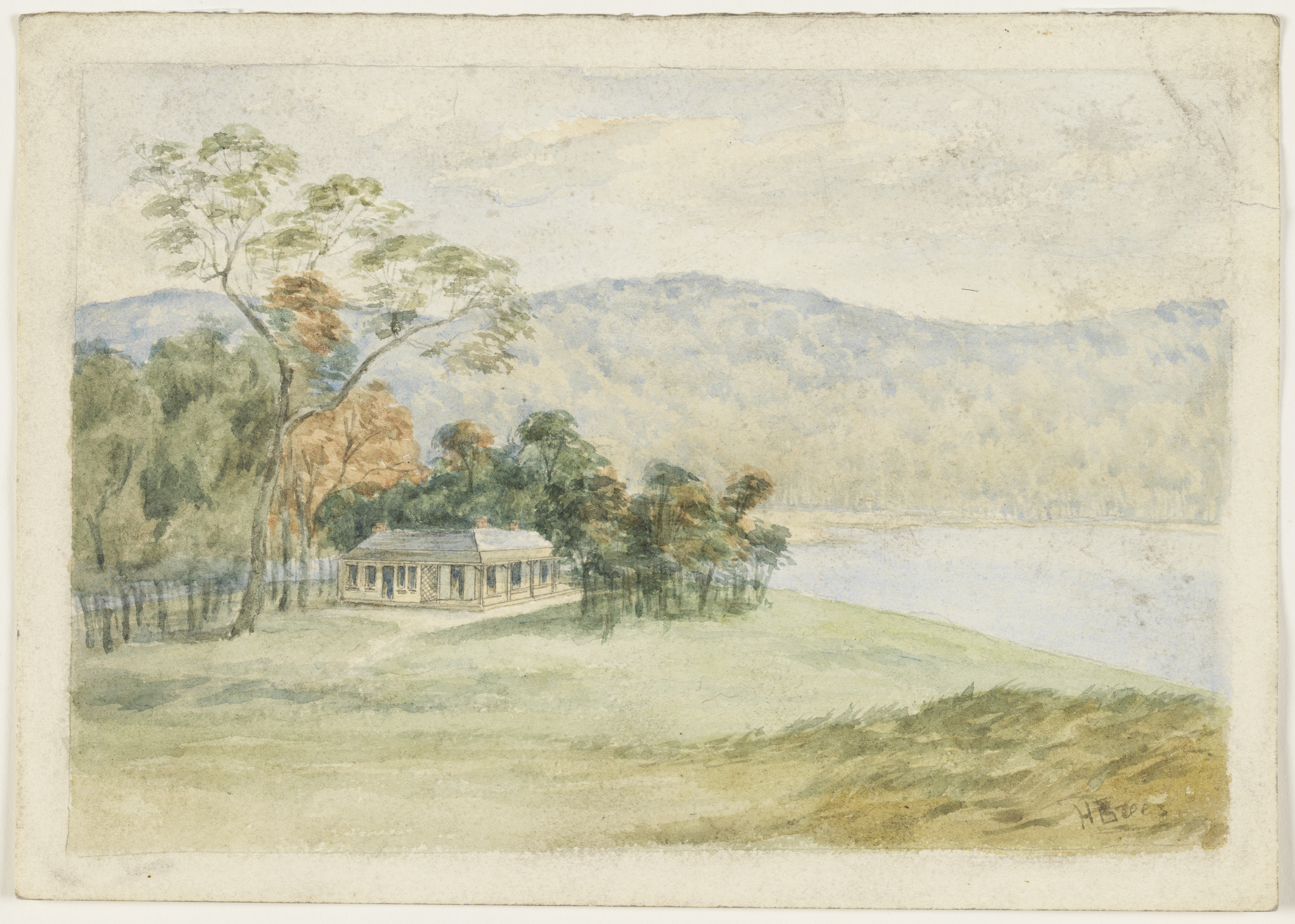
Pittwater scenes, 1880 / Harold Brees, The hotel [Newport] from the River Parade, Image No.: c13730_0007_c, courtesy State Library of New South Wales.
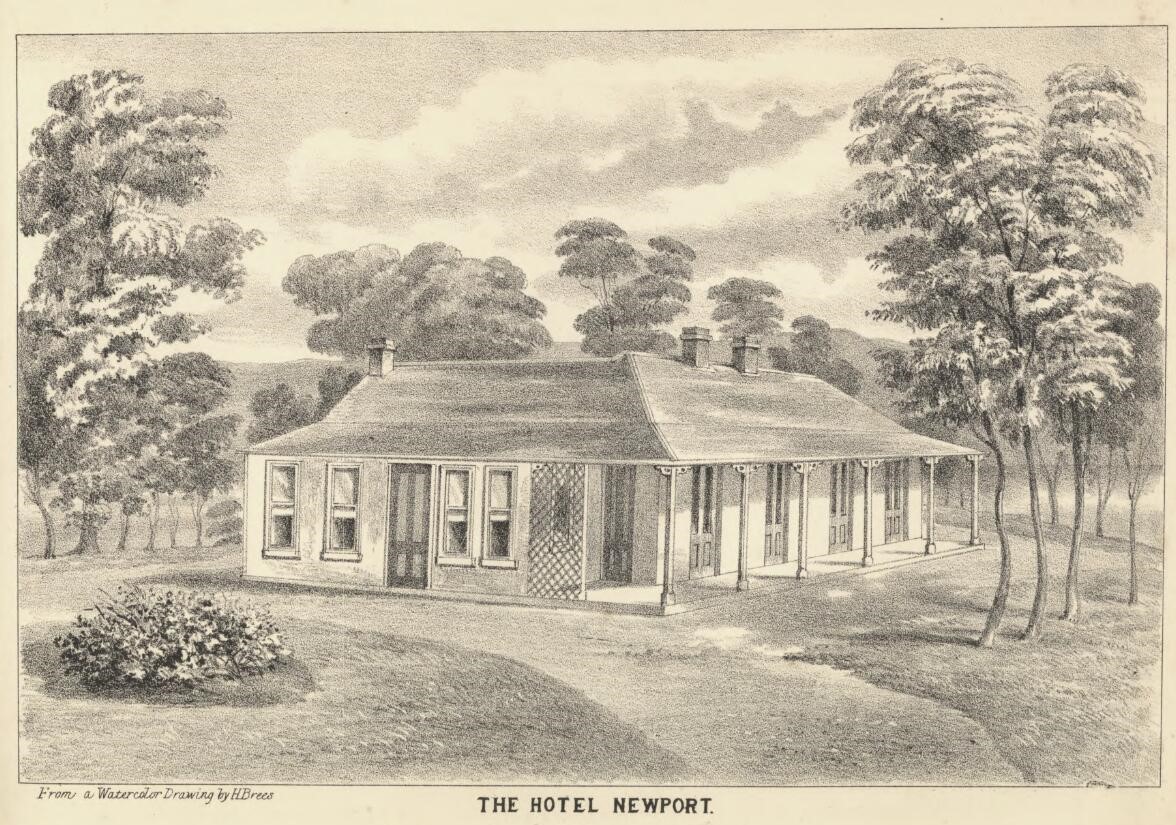
THE HOTEL NEWPORT.
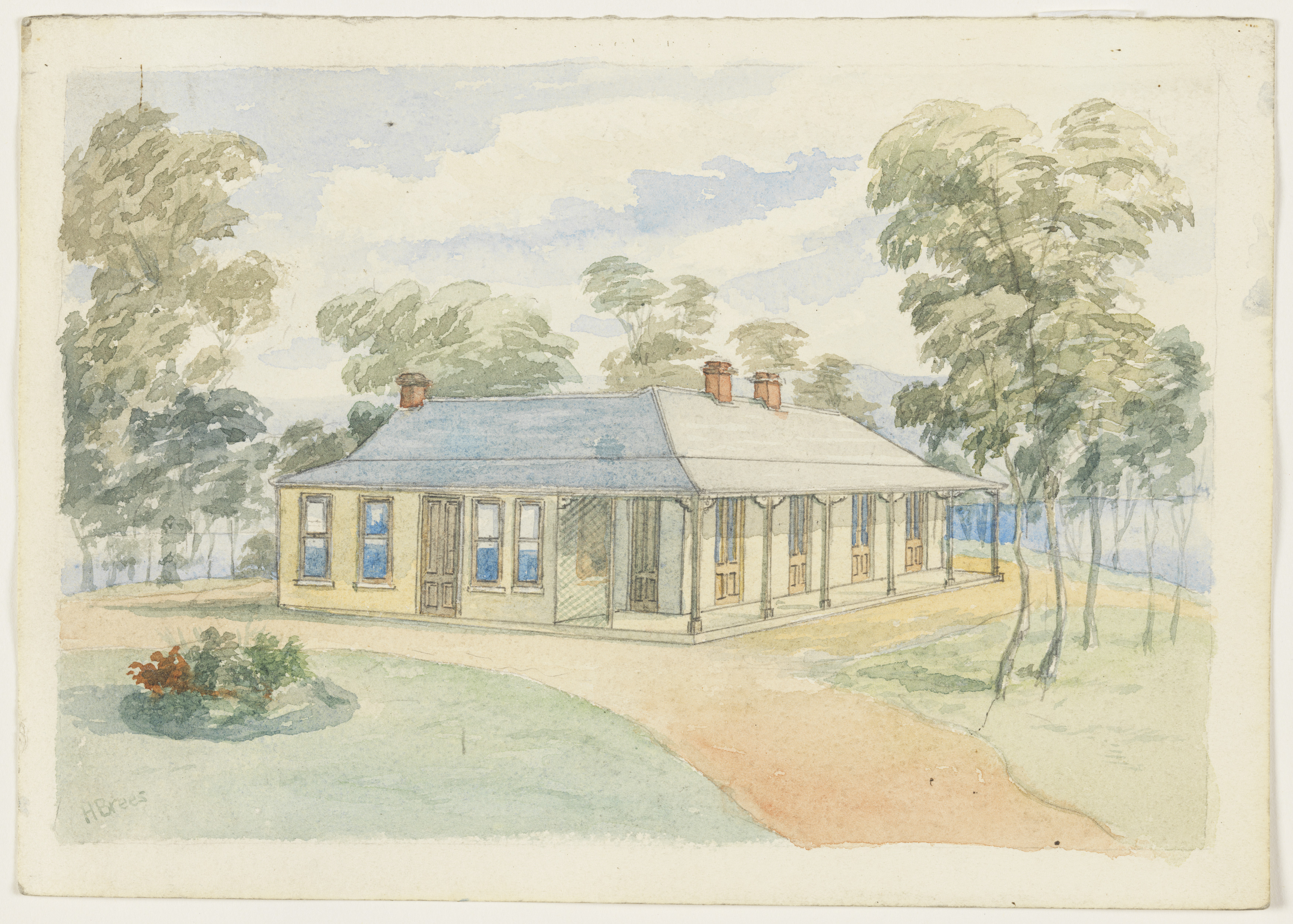
Pittwater scenes, 1880 / Harold Brees, The hotel, Newport, Image No.: c13730_0011_c, courtesy State Library of New South Wales.
PITTWATER, a splendid view of which can be obtained from Newport, is the widest arm of the Hawkesbury, and the one whence the Sydney traffic must come. It is about half a mile wide there, but below it spreads out to a width of two miles. On the eastern shore the country is hilly, but scarcely mountainous although Mount Loftus rises to an altitude of over four hundred feet; but on the western side the hills attain twice that elevation. There are numerous inlets ; some of them extending a long way among the hills, and which are almost strangers to the foot of man, and doubtless abound with wallaby and other marsupials.
SCOTLAND ISLAND is in full view from Newport, and its shores are celebrated for fine fish ; and, across the mountains, Cowan’s Creek, the next arm of the Hawkesbury, above Pittwater. This is a magnificent sheet of water, extending far up almost to the head of Lane Cove, and abounds with sport of many kinds.
MOUNT LOFTUS is the property of Mr. Farrell, of Manly. The view from its highest point is unsurpassed. The whole of the coast, from the Illawarra dittrict to Tuggerah, is spread out in full view—with the numberless promonitories, which look quite small elevations. South Head looks almost at your feet, and the houses of Woollahra, quite diminutive; to the north, Brisbane Water shows itself, and to the west peaks of precipitous mountains mark the course of the lower Hawkesbury.
LORD LOFTUS POINT was evidently in times gone by a favorite camping ground of the Pittwater aboriginals. It presents signs unmistakeable to old bushmen of having been one of the head quarters of some of our predecesssors—probably of a large tribe.
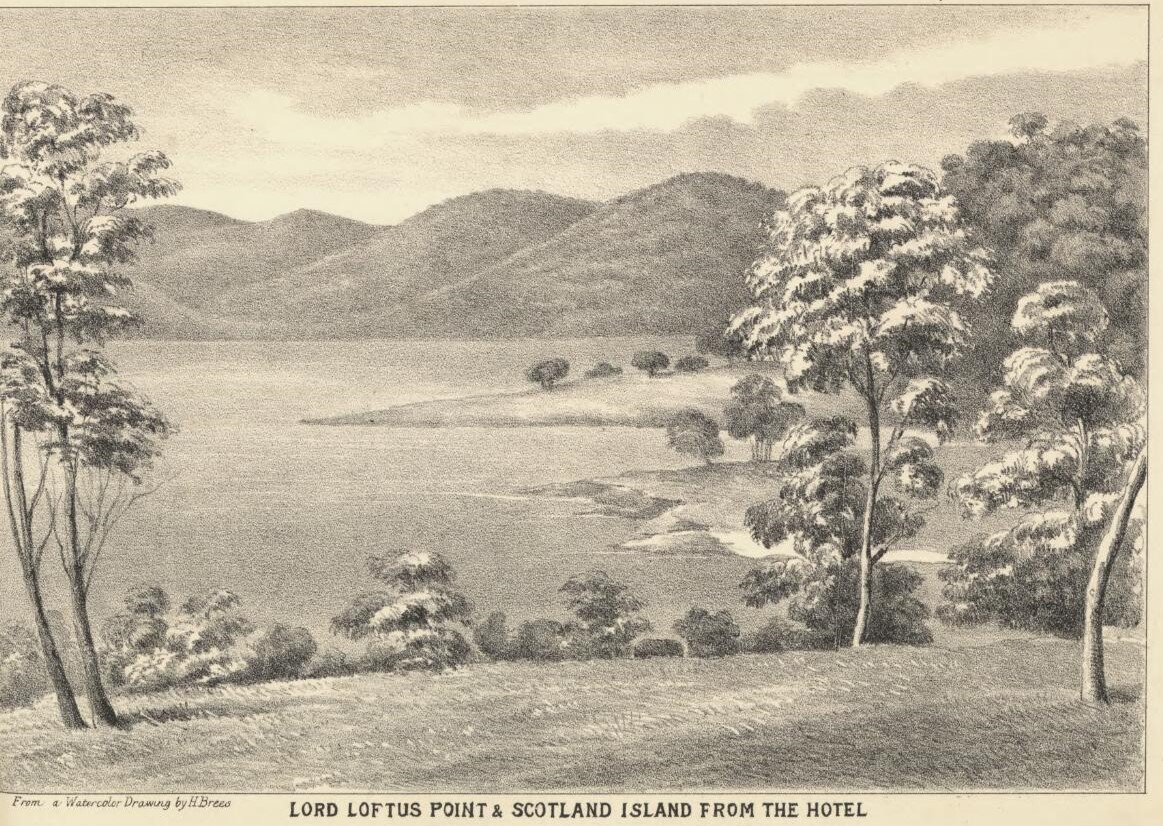
LORD LOFTUS POINT & SCOTLAND ISLAND FROM THE HOTEL
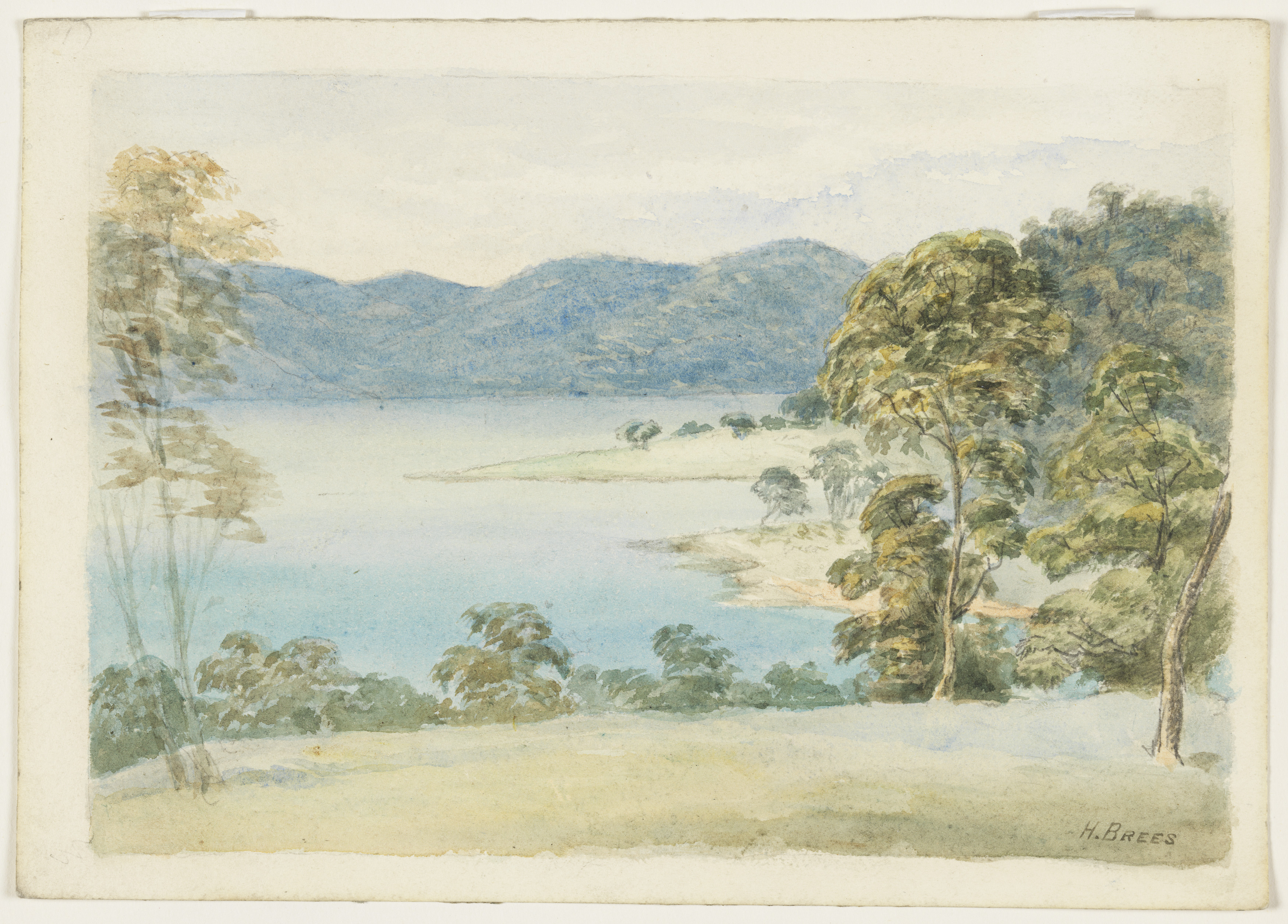
Pittwater scenes, 1880 / Harold Brees, Lord Loftus Point and Scotland Island from the hotel (Newport), Image No.: c13730_0009_c, courtesy State Library of New South Wales.
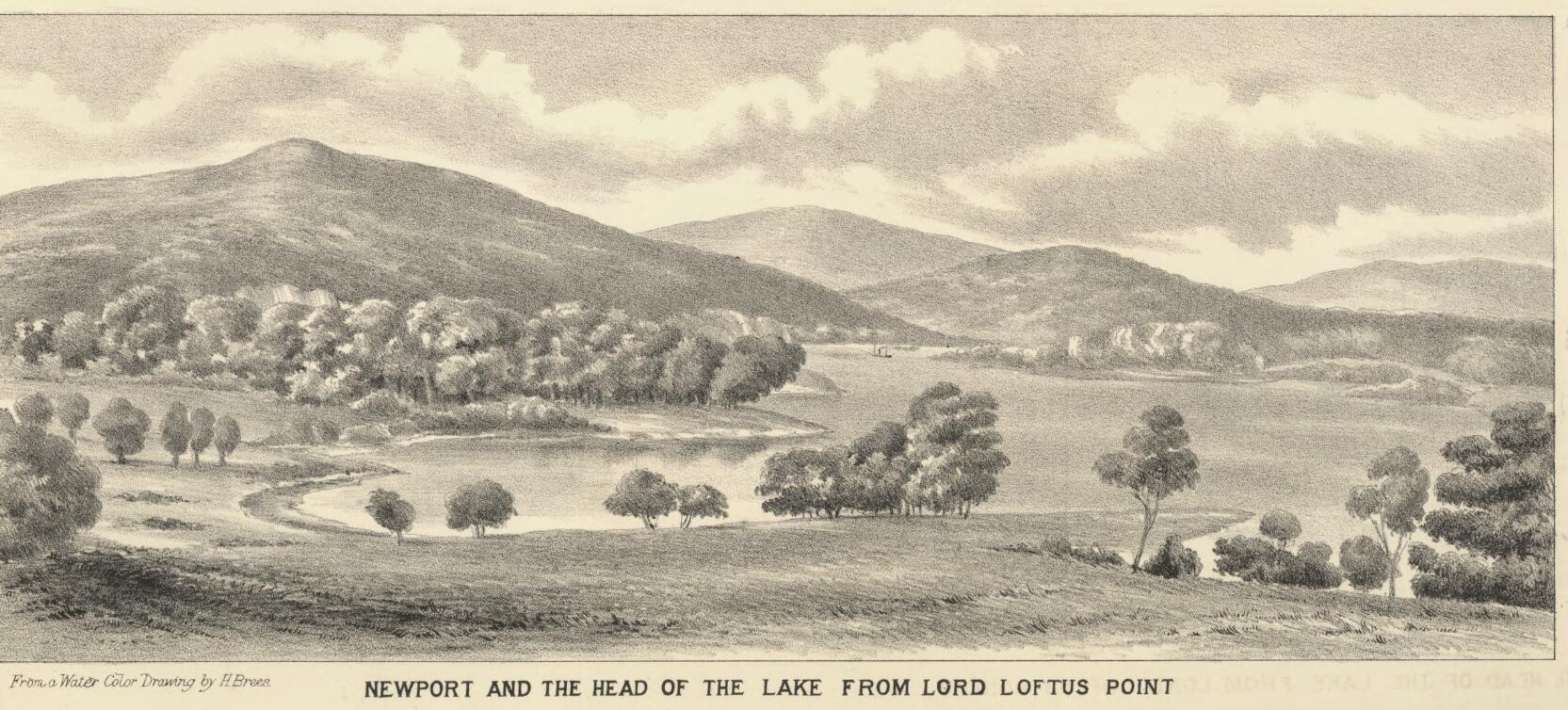
NEWPORT AND THE HEAD OF THE LAKE FROM LORD LOFTUS POINT
Seeing this, and looking at the immense extent of the Hawkesbury waters, the home of so many hostile tribes, it requires no great stretch of imagination to bring back to us from the far gone times scenes of the conflicts between them, the many battles which have been waged; the mighty fleets which may have descended from the upper river, or from Brisbane Water; what dire combats may have been fought; what mighty heroes slain— only no historian has handed to posterity their doughty deeds.
But it is always the same on the dawn of history, we are told—
“ Before great Agamemnon’s reign,
Reigned kings as great as he, and brave ;
Whose huge ambition’s now contained
In the small compass of a grave,
In endless night they sleep unwept, unknown ;
No bard had they to make all time their own.”
working out their destiny on their own lines. Longfellow has in singular metre but in beautiful words placed in the mouth of his hero Hiawatha a prophecy meant for the Redman of America, but equally applicable to our aborigine Australians—
“ I beheld the westward marches
Of the unknown crowded nations ;
All the land was full of people—
Restless, struggling, toiling, striving.
In the woodland rang their axes,
Smoked their towns in all the valleys,
Over all the lakes and rivers
Rushed their great canoes of thunder.
Then a darker, drearier vision
Passed before me—vague and cloud-like :
I beheld our nations scattered.
All forgetful of my counsels,
Weakened, warring with each other—
Saw the remnant of our people
Sweeping westward, wild and woeful,
Like the cloud-track of a tempest,
Like the withered leaves of Autumn.”
History repeats itself. As was the history of the American Indians, so the history of the Pittwater tribes. Formerly they were great and numerous at Pittwater Lake, like in America at the almost equally beautiful Lake of Saratoga; in both places they have passed away. Now at Saratoga numberless villas, magnificent hotels, and a prosperous town have taken the place of the Indian wigwams. In the course of a few years, in place of the gunyahs of the blacks, another Saratoga will arise at Newport, a far more beautiful place, and which will be what Saratoga will never become—the favorite sanatorium, as well as the yachting centre of the country.
There were no special correspondents in those days, and the traditions of the natives have not informed us whether the various tribes maintained ambassadors at each other’s courts under the gunyah to negotiate peace or to declare war. Nor do we know if their wars were for plunder or conquest, or on the other side for liberty;—and it must be remembered that there have been numberless martyrs for liberty’s sake among the black nations ; let Touissant I’Overture of Hayti, or the great Arabian hero, “ Antar ” (the theme of so much Arabian poetry), bear witness— all great nations were not of oiir race; indeed, Darwin describes an individual as a true hero, belonging to quite a different tribe.
It is sad to contemplate the decadence of a great nation, the silent melting away of a numerous people, even one not civilized as we understand the term in these advanced days, yet having the same human affections, strivings and aspirations as ours, and
GEOLOGICAL SKETCH.
The following lines relating to the surface rocks of the Hawkesbury are taken from the Rev. W. B. Clarke’s valuable work on the “Sedimentary Formations of New South Wales“ Over the uppermost workable coal measures which are of considerable thickness, is deposited a series of beds of sandstone, shale and conglomerate, oftentimes concretionary in structure and very thick bedded, varying in composition with occasional false bedding, deeply excavated, and so forming deep ravines with lofty escapements to the upper part of which series I have given the name of the ‘ Hawkesbury Rocks/ owing to their great develop- quite unnecessary. Let it suffice to say that they were, taken altogether, as fine a lot of fellows as could be met with in a day’s march, and they thoroughly knew how to enjoy themselves.
The party left Sydney early in the afternoon, and after the now well-known drive from Manly, arrived at Newport before sunset. Arrangements had been made for a shake-down at the hotel, then unfinished, and provisions sufficient for twice their number had been sent from Manly. Therefore, after doing full justice to a hearty dinner and a fair supper—late to bed and early to rise, then a substantial breakfast, the party embarked on a pretty little steamer named the “Florrie,” at half-past seven in the morning.
It is unnecessary to describe the trip down Pittwater, it is so well-known, but on this occasion the channel on the western side of Scotland Island, instead of the usual course on the eastern side, was chosen, and the party had an opportunity to view the pretty cottages on the western side of the bay, a pretty building, evidently a church with tombstones around, showed that the ordinances of religion are not forgotten there. As each point was passed, and fresh inlets revealed, exclamations as to the beauty of the ever-changing scenery were often simultaneously made by everyone on board. The little steamer sped swiftly on her way to the great River, where a disappointment was met with, for rolling down from the mountains, covering the entire breadth of the valley, was encountered a thick fog, completely hiding the opposite shore; even Elliot Island in mid stream was indiscernable.
“Well,” said Brown, as the headland on the west of Pittwater was passed, “ this is provoking ; the fog might surely have waited another day, and left this day clear for us.” “ But, what opening is that to the left ?’ said another. “ Why,” answered Campbell, “that is Cowan Creek, which heads near Lane Cove.”
“ There is a queer superstition about Cowan Creek—or, rather, there was when I was a boy,” remarked a quiet individual of our party. At this moment the sun burst through the fog, revealing for a short time some land up the broad sheet of water we were passing. “Do you see that headland,"he continued. We all looked where he indicated "it was ; said he, “ whenever the moon rose at midnight in winter, that headland is haunted by the ghost of a man who was killed there many years ago. If you like,” he added, as the fog has come down again, “ I will tell you the story.”
We all pressed him to begin
THE GHOST OF COWAN CREEK.
“ Many years ago, before it was anticipated that this country could be anything else than a convict settlement, before the blue mountains had been crossed, or railways thought of, and when both barristers and attorneys lived lovingly together in one wigwam, there resided not many miles from Windsor a wealthy settler. He had received a grant of land from the Government, and, as was usual in those days, had an assignment of men, and was allowed rations with them. He was a violent-tempered man, but generally liked by his servants, being withal of a generous disposition. We will call him Thorpe, but that was not his name. ‘ About two years before the occurrences which I am about to relate there were in a merchant’s office in the city of London two brothers named Judd, one of whom had just been married; the other, the younger, was very wild in his habits, and had contracted heavy gambling debts.
One day a large sum of money was drawn from the firm’s bankers by a cheque which proved to have been a forgery. A great commotion was made in the office, and on search being made, the money was found in the elder brother’s desk. He protested his ignorance as to how it came there—it was useless. He was tried and convicted, and transported to Australia, and assigned to Mr. Thorpe. His broken-hearted wife realized what little property they had, and followed him to Sydney, where she managed to engage as servant to Mrs. Thorpe.
Thus the husband and wife were living on the same farm.
“ But though so near to each other, they were not living together, for the settler would not hear of the husband being in the house, and the truth must be told that Mrs. Thorpe liked being waited upon too well to allow her servant away from her much. So poor Judd had to live among the men at the huts, and saw but little of his wife.
“ Mr. Thorpe had a younger brother, a settler higher up the river, who, being a single man, was frequently a visitor at his elder brother’s house. He took a great liking to little Mrs. Judd, and she, being of a happy disposition, and again near her husband, had settled herself down to her altered circumstances, and was again quite cheerful. Indeed, it must be confessed that she liked admiration, and was proud of the attentions of the handsome young settler. I am quite certain that she was true at heart to her unfortunate husband ; but in a large establishment there are sure to be tale-bearers, and the exaggerated tales of stolen interviews met his ears almost every day.
“ He was a man of a mild, affectionate disposition, and was known among his rough fellow-workmen according to the fashion of those days, by a nick-name—“ The Baby,” he was called. His whole nature seemed now to change ; the injustice of his sentence, and now the infidelity as he thought of his wife, maddened him ; he became moody, and violent in his conduct towards her. They had a stormy interview one evening, and he was seen on the farm no more, and his wife disappeared with him. It was discovered soon after that the only boat the farm possessed had gone also—so it was clear that they had gone down the river.
“ After two days delay a party of constables started to bring back the runaways. They searched for them up the bays and inlets for several days without success, and looked vainly over the numerous islands with which the lower part of the river is studded, nor could they glean any tidings from the blacks, and were returning back again, giving up the search, when passing the mouth of Cowan Creek some faint smoke was observed behind the promontary I showed you.
They pulled up to the spot; they saw Judd standing on some rocks with a gun levelled at them. He fired and missed; almost at the same moment they fired at him ; he fell shot right through the heart, and his wife rushed down from a hut they had built and fainted on his body. They hurried him near where he fell; no tombstone marks the spot, but it is said that his ghost haunts the hill, and can be seen at certain times hovering over the place.
“ His wife was taken back to the farm and soon recovered under the kind treatment she received. She did not die them ; oh, no ! She married again a few years afterwards, and her descendants are numerous throughout the colony. She died about twenty years ago.
“ Well,” said Campbell,” of all the stupid tales I have ever heard yours is the worst; let’s have some mountain dew to wash down this Scotch mist. I have some which was made a present to me, and it is unequalled. “I ” said another,” have some which I imported myself. I will leave the company to judge which is the best. We then tasted the whisky and discussed it, and the Ghost of Cowan Creek was soon forgotten.
The fog by this time quite cleared off. “ See,” said Smith, “ look ahead.” It was indeed a beautiful view which burst upon us. To the left, on on enchanting island with green slopes, stood several pretty cottages, while across the river a great range of mountains wending to the left, with bands of mist half-way up their summits, forced the course of the river at right angles from its former direction.
Amid scenes like this we continued our way until dinner time, passing two neat looking churches, at which we were told a clergyman comes all the way from Ryde to preach. At Wiseman’s Ferry we were struck with the immense stretch of the telegraph wires—probably, when the Hunter River traffic passed that way, the Ferry was an important place ; the large stone church now in ruins proves as much.
It is not attempted to describe the Hawkesbury—that task were an impossible one, except, perhaps, for a Buchanan—nothing but adjectives could be used, and these should be mostly superlative words. “ Glorious,” “ magnificent,” “ grand,” “ wonderful,” “extraordinary,” “ this licks creation,” “ most remarkable,” “ unsurpassed in this world,” &c.—these are fitting terms, and yet prove quite inadequate, poetry almost equally so; even Byron, our greatest descriptive writer, did not attempt to describe the Rhine, how could anyone attempt the Hawkesbury ; yet in steaming up the stream and looking at any one of the many beautiful islands, these lines of that poet, slightly altered, flash across the mind :
Oh, that this islet were my dwelling place,
And some soft spirit for my minister ;
Then I’d forget about the coming race,
Think of no others, love but only her.
It is astonishing how you enjoy your food when travelling.
Most of the party had brought provisions, and from what one of
them had provided it seemed that he thought he had to feed the entire
party; yet the good things disappeared like magic. It is evident
that on a trip like this there is little need to nurse your appetite.
We passed a pretty church about dinner time, and saw a few
people leaving it—possibly a wedding party, all in their Sunday
clothes. What a universal thing is love, how it gladdens even
this secluded place. Scott tells us
“Love rules the court, the camp, the grove,
And men below, and saints above ;
For love is heaven and heaven is love.”
Byron, however, tells us that heaven is not love, but matrimony—he ought to have known, as he had the reputation of being an authority on both sides of the question—if so, it was heaven we saw coming out of the church, hand in hand.
After passing Wiseman’s Ferry, the country opens out and softens ; the mountains disappear, and are succeeded by pretty hills; numerous small farms and orchards come in view one at a time ; and, at Kent’s Reach, where we disembark, the good farming country commences. Suitable conveyances bowl us swiftly along a good road to Windsor, where we stay the night.
By half-past nine next morning we are all at our offices* thoroughly renovated by our most enjoyable trip, and capable of such a quantity of work that, should succeeding generations know the amount we got through during the next week, they would hold up their hands in astonishment and exclaim—“there were giants in those days.”
We were absent from Sydney but one afternoon, two nights and one day ; we travelled by steamer, coach, and rail, one hundred and fifty miles along a most picturesque route ; but on what day we departed and on what day we returned this deponent sayeth not.
NOTES OF A TRIP TO BRISBANE WATER AND TERRIGAL.
From Newport to Brisbane Water the route is down Pittwater, across the Hawkesbury, and up the small river to Blackwall and the Broadwater. The channel at the entrance is narrow, soon opening out into broad sheets of water, branching in every direction. The “ Broadwater,” which extends up to the town of Gosford, is truly a splendid lake. The “ Kincumber” lakes join opposite Blackwall, and there are various others. Anyone fond of boating could spend a week comfortably among these inland waters, and, we think, find some fair sport, both in fishing and shooting.
Gosford is but a small town, with a Court House, three churches three hotels, two stores, and a blacksmith’s shop. The timber trade is the principal, or rather the entire support of the place. From what we could learn, the residents are doing very well—indeed the appearance of everyone we met told the same tale. We did not during our stay see a single case of apparent poverty, everyone looked comfortably off; and further, we never saw anywhere else so many nice-looking, clean, healthy and well-dressed children.
The wages current at the mills and in the bush is, we are informed, two pounds per week, fully equal to three pounds in Sydney. Horses are plentiful, and our obliging host, Mr. Campbell, supplied us for our ride to Terrigal, which lies across the mountains on the ocean side, about eight miles away. Our road lay for some three miles alongside one of the navigable creeks which discharge into the Broadwater. At various places wei’e stacks of timber ready for shipment or being shipped, and at one place no less than ten teams with the loads, principally laths and logs for the Sydney mills. Some of these teams had come from places seven miles inland. Until we were within three miles of the ocean we saw very little growing timber of any value, the land being barren and uninteresting ; but for the last three miles the country was splendid and similar in appearance to the celebrated Bulli Pass—magnificent trees of great size growing alongside the track, festooned with creepers of various kinds up to their topmost branches.
Terrigal is the property of Mr. Thomas Davis, and comprises several thousand acres between the ocean beach and the coast range of hills. Some of the land is of the richest description, and is thickly covered with turpentine and other choice timber. The saw mill is close to the ocean beach, and the vessels are loaded at a small wharf, in a position very similar to Cabbage Tree Bay, Manly. Yet Mr. Davis informed us that he has never been prevented shipping from his wharf, even in the roughest weather.
The establishment is a very large one, employing over forty men, and the quantity of logs sawn up so great that he has had to construct a wooden railway—over two miles in length—from his mill to an inland lake, to be able to work up the trees from all round its shores.
A great deal has been said and written about our timber supplies, and fears are entertained that unless we have large reserves, our forests will soon be destroyed. A visit to Brisbane Water should convince those most sceptical as to the future of the folly of such fears—at least as far as the coast districts are concerned. It is about thirty years ago that the large timber trade with Gosford commenced, and already a second growth of goodly sized trees is covering the country, to be ready in another few years for the saw mill. In other parts of this colony we have invariably observed a similar result. We especially remember a large district of open forest where the few trees were destroyed by ringbarking ; —within five years afterwards the whole country was covered by a thick growth of young saplings. The fear rather is that this second growth will come up too thickly for any of the trees to arrive at maturity. Of course these remarks do not apply to our valuable red cedar, which must disappear if steps are not taken to prevent it.
Before leaving Gosford we climbed the hill in the recreation ground, and were well repaid for our trouble. The height, our aneroid informed us, is a little under three hundred feet, and the width at top about forty feet in the widest point. The view exceeds any we have ever seen—the whole extent of Brisbane Water, with the various bays and headlands, was spread out before us ; far in the distance, stretching to the south, is Pittwater and its mountains ; in the west the Hawkesbury breaks through the hills, and right in the centre of its course is Eliot Island, like a crouching lion with face towards the ocean, guarding the entrance of this magnificent wilderness of waters. It is impossible to look from the spot whore we stood without seeing that, at a comparatively recent date, Pittwater and Brisbane Water together formed one inland lake—a depression of the coastline of about twenty feet would restore its ancient features. But what a change that would bring about in the form of our coast.
The North Head of Port Jackson would then become an island : four islands would be formed between Pittwater and the present ocean ; and the western side of Pittwater would become the true coast line. It is quite common to hear the Hawkesbury designated as the Rhine of Australia. Not having been privileged to visit the river of Germany, we have not seen the resemblance. True, there may have been many pitched battles on its banks between the varions native tribes, as there were battles between the Romans and the Germans on the European stream ; but if the native bards sung of those great deeds, such songs have not been printed. We have an account of the Rhine from our great descriptive poet: —
And peasant girls with deep blue eyes,
And hands which offer early flowers,
Walk smiling o’er this paradise.
Above the frequent feudal towers
Through green leaves lift their walls of gray,
And many a rock which steeply lowers,
And noble arch in proud decay,
Look o’er this vale of vintage bowers.
We do not think that the above will apply to our river ; in fact the Hawkesbury is thoroughly Australian in its character and scenery, and, besides, is like no other river in Australia, but has a character enth’ely its own. It is unlike the Hunter on the north, unlike the Macquarie on the west, unlike the Shoalhaven on the south ; and from its bold romantic scenery, the great extent and diversity of its imprisoned waters, and from its numerous branches, it forms altogether the most wonderful estuary in New South Wales, So much for our trip tip the Hawkesbury and Brisbane Water ; but not even these localities, with all their charms and beauties, comprise the importance of the Town of Newport, It will now become the main avenue of traffic and travel with Barranjoey, Blackwall, Gosford, Kincumber, Terrigal, Cooninburg, Lake Macquarie, and the Juggerah Lakes, and on to Newcastle overland, affording both to tradesmen and tourists at once conveniences and pleasures never before at their command. To the one a ready and speedy access to his home, and to the other all the delights of scenery, exploration and sport that the artist, scientist, or holiday-maker could possibly desire.
To some of these localities it is the purpose of a few to take trips ere many weeks go past, and we doubt not we will be able to render as favorable an account as these given of our Hawkesbury tour to Windsor and Brisbane Water.
Collision between the Steamers Pelican and Emu.-Yesterday morning as these boats were running their usual trips to and from Parramatta, a slight collision took place. Mr. Brett, the master of the Pelican, has furnished us with the following particulars:-At about9 30 a.m., when rounding Pulpit Point, both kept close in shore; the Pelican was coming down the river, being close in under the point, consequently the other boat could not see her until within a ship's length of her. The Pelican attempted to pass on the port side, but finding she could not do so without doing serious damage, stopped the engine and kept close in along the shore.
The Emu also attempted to pass nearest the point, and not having room to go between the other boat and the rocks, and there not being time to shift the helm sufficiently, both vessels struck with their paddleboxes. The wheels of both vessels were crippled, and a small deck house of the Emu carried away, beyond which we believe the damage to be trifling. One person, who was standing by the rail, was thrown overboard by the shock of the vessels meeting, but he found his way ashore without any injury save a wet jacket. Both vessels were being repaired last evening, and will, we believe, run their trips to-day as usual. Herald, June 7. SHIPPING INTELLIGENCE. (1855, June 9). The Maitland Mercury & Hunter River General Advertiser (NSW : 1843 - 1893), p. 2. Retrieved from http://nla.gov.au/nla.news-article702087
Collision of the Emu and Pelican steamers on the Parramatta River [picture] by Walter G Mason. [Sydney : J.R. Clarke, 1857] 1 print : wood engraving ; 13.5 x 21.5 cm. Part of The Australian picture pleasure book : illustrating the scenery, architecture, historical events, natural history, public characters &c., of Australia Sydney : J.R. Clarke, 1857. nla.pic-an7975496 courtesy National Library of Australia
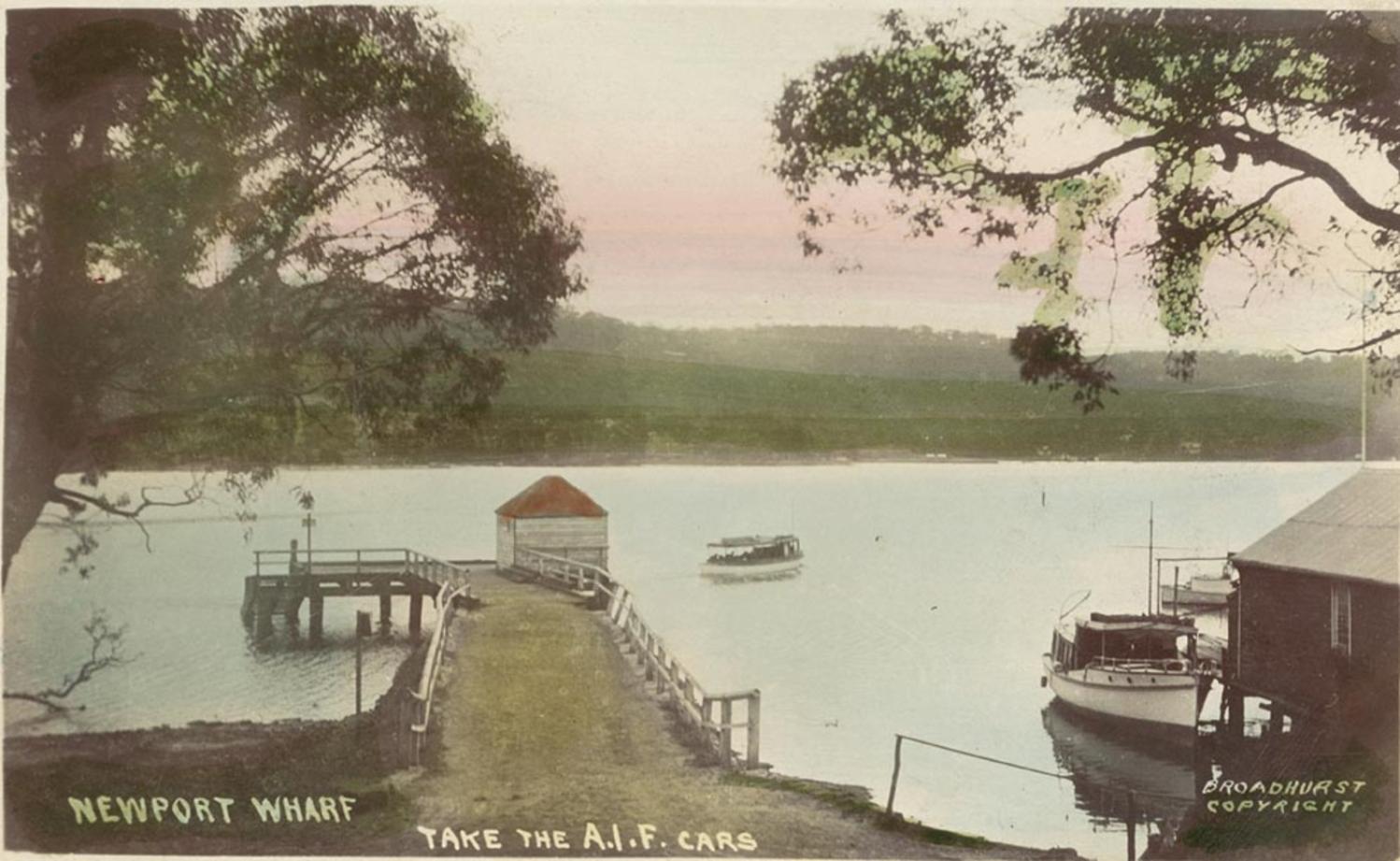
Newport Wharf No. a106119 ca. 1900-1927 Sydney & Ashfield : Broadhurst Post Card Publishers from Album Scenes of Newport, N.S.W., courtesy State library of NSW
